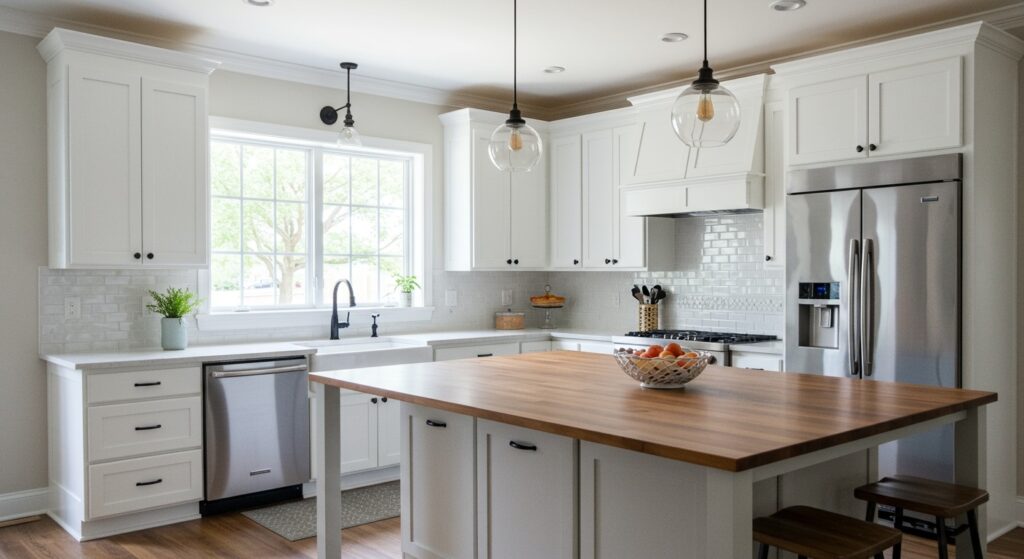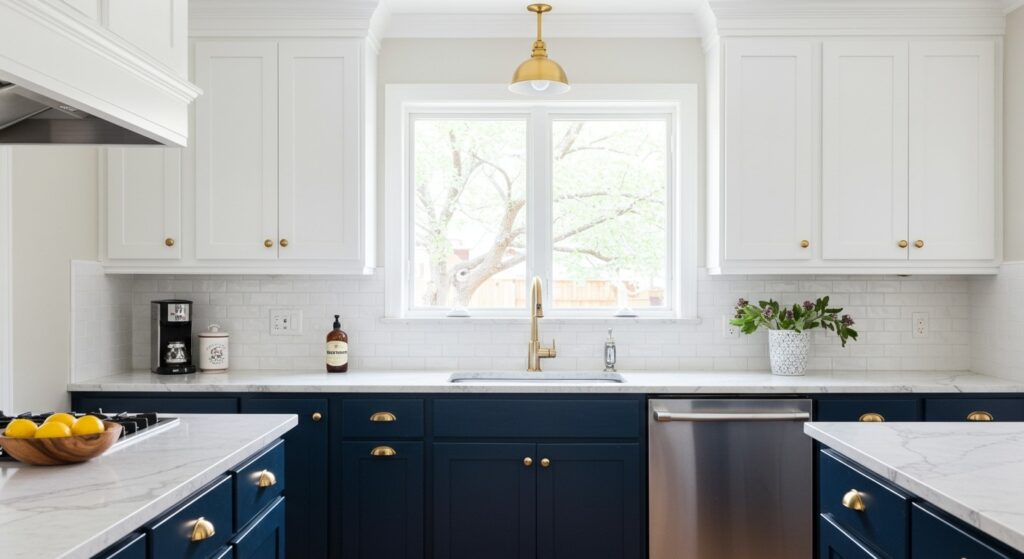There’s something undeniably inviting about a modern farmhouse kitchen. Maybe it’s the way natural wood tones ground a space, or how a simple apron-front sink can anchor an entire design scheme. Whatever it is, this style has captured hearts (and Pinterest boards) everywhere.
But here’s the thing – creating a modern farmhouse kitchen isn’t about copying a catalog look. It’s about finding that sweet spot where rustic warmth meets contemporary convenience, where your grandmother’s cast iron skillet feels right at home next to your smart coffee maker. Whether you’re working with a sprawling space or a compact galley, these ideas will help you capture that cozy-meets-functional aesthetic.
I’ve gathered 27 ways to bring this beloved style into your home. Some are small tweaks you can do this weekend, others are bigger commitments. What matters is finding the elements that speak to you and your cooking life.
1. Shiplap Accent Wall Behind Open Shelving
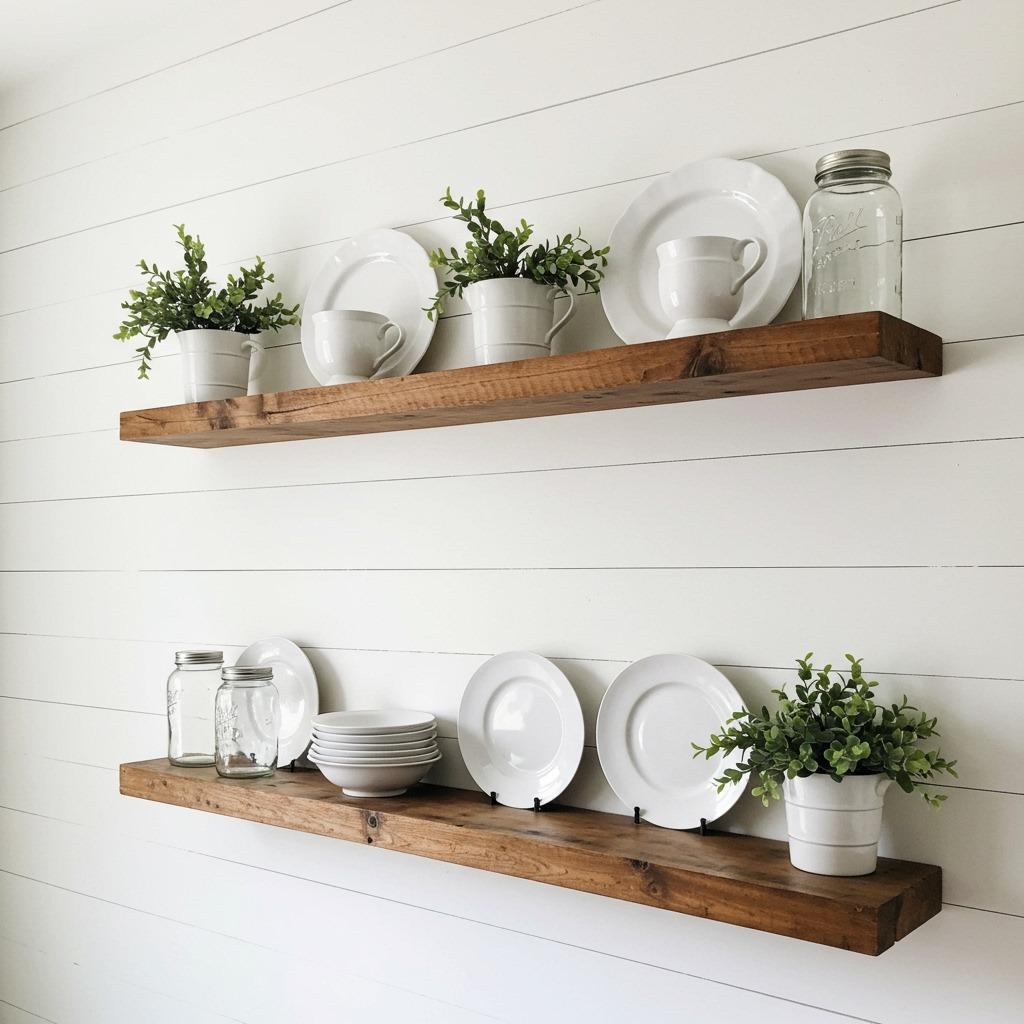
Shiplap brings instant farmhouse character to any kitchen wall. The horizontal lines add visual interest without overwhelming the space, especially when painted in soft white or cream tones. What makes this work so well behind open shelving is the layered texture – the linear shiplap provides structure while your displayed items add personality.
Consider running shiplap on just one wall rather than the entire kitchen. Too much can feel like you’re trying too hard. The wall behind your sink or stove makes an ideal focal point.
Installation is surprisingly manageable for DIYers. You can find pre-primed shiplap boards at most home improvement stores, and the gaps between boards are forgiving of small imperfections. Just remember to locate your studs first if you’re planning to hang open shelving above it.
2. Butcher Block Island Countertop
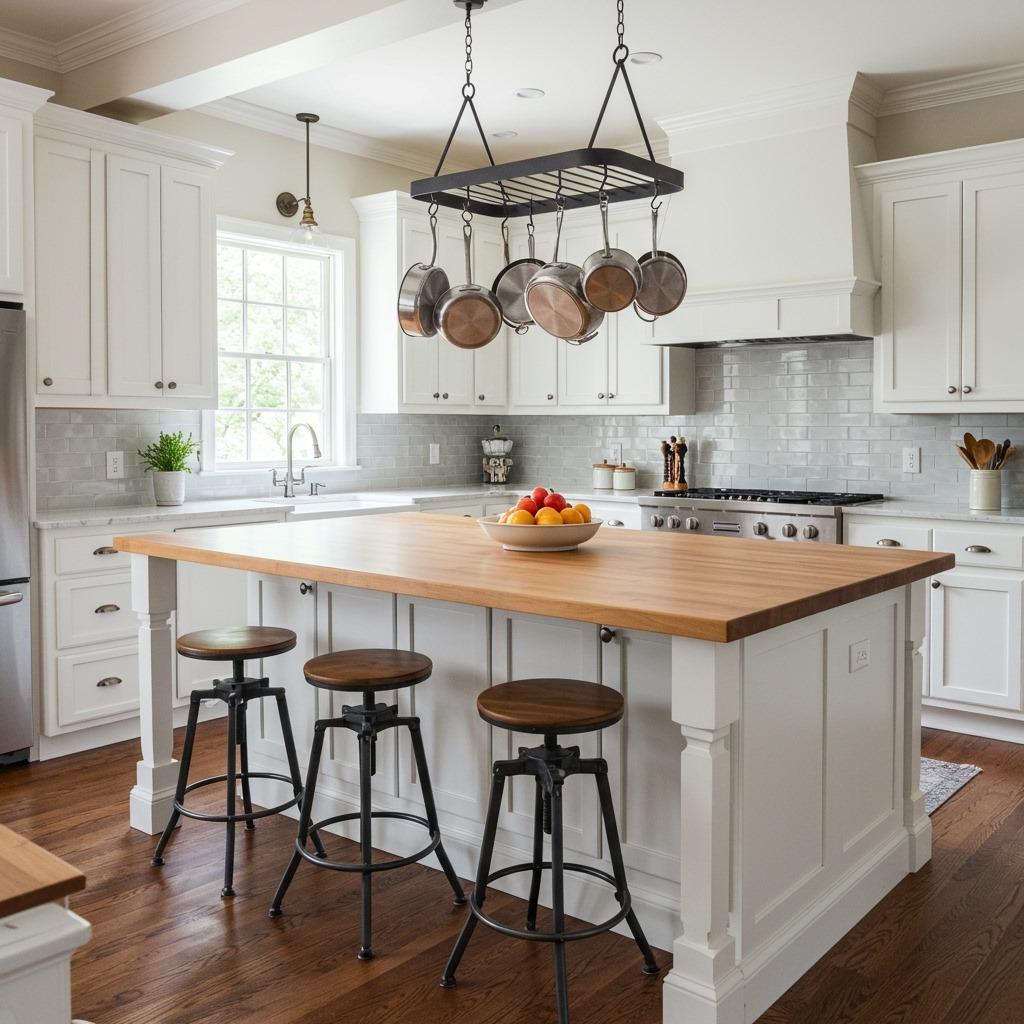
Nothing says “this kitchen is meant for cooking” quite like a butcher block island. The warm wood tones create an inviting prep space that practically begs you to roll out pie dough or chop
fresh vegetables. Unlike cold stone surfaces, butcher block has a tactile quality that makes your kitchen feel lived-in from day one.
The natural variation in wood grain means no two islands look exactly alike. Oak and maple are popular choices for their durability, while walnut offers richer, darker tones if you want more contrast against white cabinetry.
Yes, butcher block requires maintenance – regular oiling and the occasional sanding to remove scratches. But many people find this ritual satisfying, almost meditative. The surface develops character over time, with knife marks and patina telling the story of countless family meals. If you’re not ready to commit your entire island, consider a butcher block section just for prep work.
3. Matte Black Hardware and Fixtures
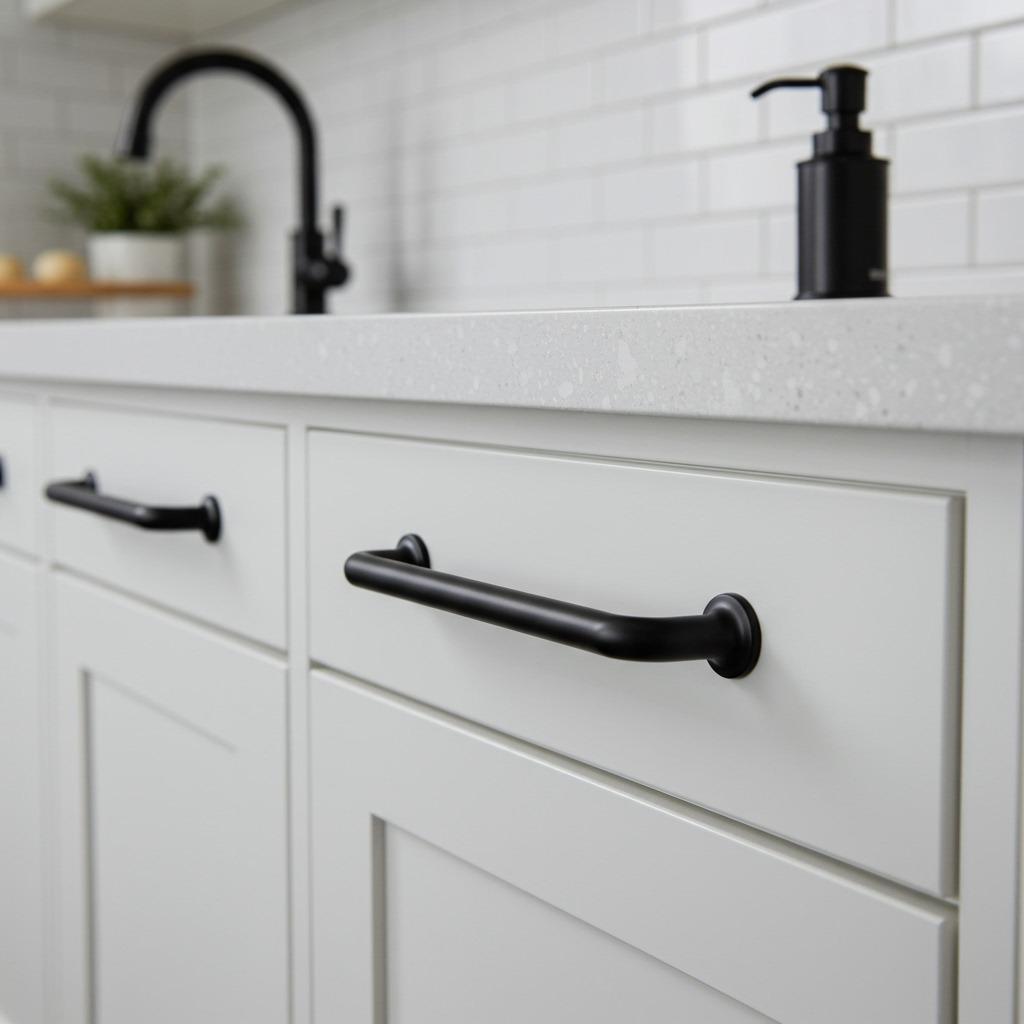
Matte black hardware has become the jewelry of modern farmhouse kitchens. These fixtures add just enough edge to keep the style from feeling too sweet or country. Cup pulls on drawers, simple knobs on doors, and coordinating faucets create a cohesive look that grounds all those lighter elements.
The beauty of matte black is its versatility. It pairs beautifully with white cabinets, natural wood, stainless steel appliances, and even colored cabinetry. Unlike shiny chrome or brass, the matte finish doesn’t compete for attention – it simply defines edges and adds subtle sophistication.
One practical note: matte black shows fingerprints and water spots less than you’d think, but it does show dust. A quick wipe-down becomes part of your routine. Still, the aesthetic payoff is worth it. This is one of those affordable home upgrades that makes a disproportionately large visual impact.
4. Farmhouse Apron-Front Sink
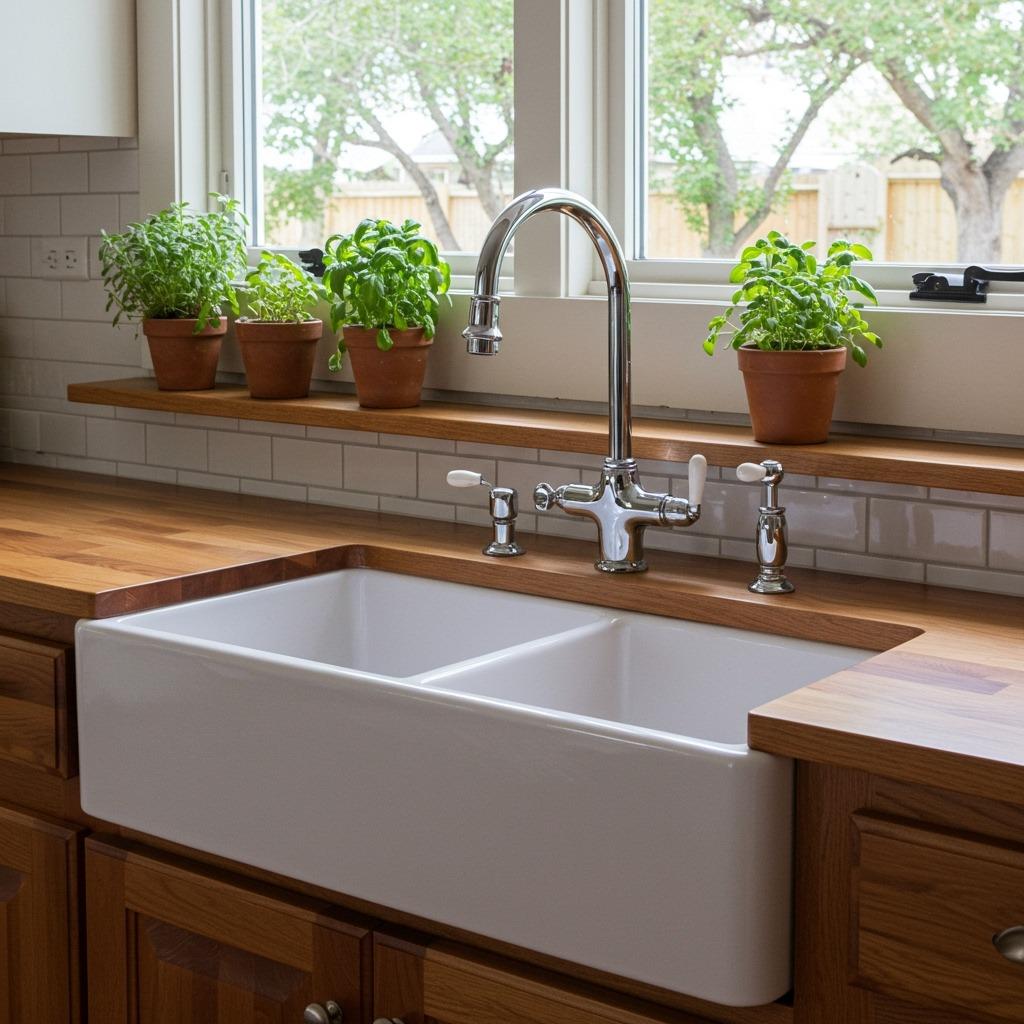
An apron-front sink is perhaps the most iconic element of farmhouse kitchen design. That exposed front panel makes a bold statement while offering practical benefits – you can stand
closer to the sink without leaning over a countertop edge, which saves your back during long dish-washing sessions.
Fireclay and cast iron are traditional materials that can handle heavy use and high temperatures. Modern versions also come in stainless steel if you prefer easier maintenance. The depth of these sinks is generous, easily accommodating large pots and baking sheets.
Installation does require specialized cabinetry since the sink sits differently than undermount or drop-in styles. If you’re renovating, plan for this early. If you’re working with existing cabinets, you might explore retrofit options, though they’re trickier to pull off convincingly.
5. White Shaker Cabinets With Inset Doors
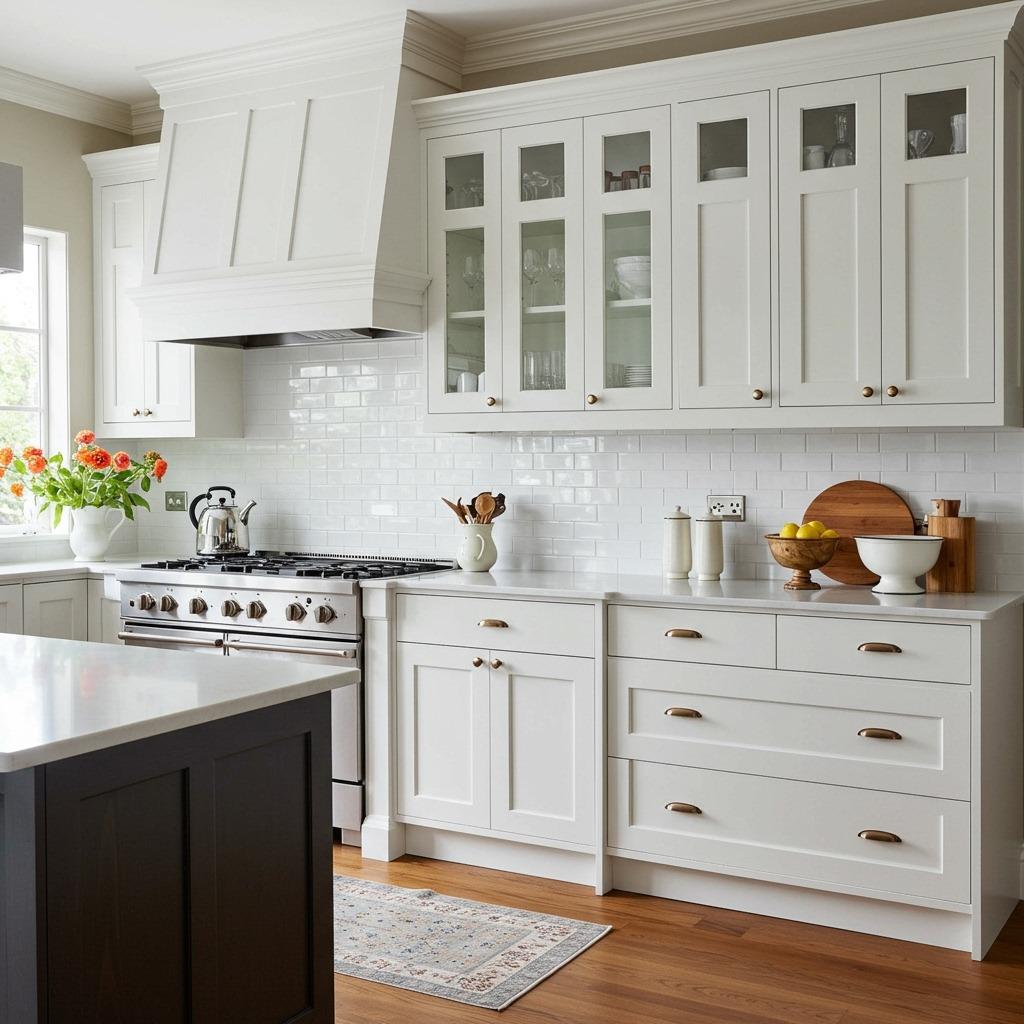
Shaker-style cabinets are the workhorses of modern farmhouse design. Their simple five-piece door construction with a recessed center panel offers enough detail to feel intentional without any fussiness. Inset doors, where the door sits flush within the cabinet frame, take this a step further by showcasing quality craftsmanship.
White cabinets keep spaces feeling open and bright, especially important in smaller kitchens. They also provide a neutral backdrop that lets you change accent colors and decor seasonally without clashing. Your grandmother’s vintage breadbox looks right at home, but so does that sleek espresso machine you saved up for.
The gap around inset doors (called the “reveal”) creates subtle shadow lines that add dimension to your cabinetry. Yes, inset construction costs more than overlay doors, but many designers consider it worth the investment. If budget is tight, you can achieve a similar look with partial-overlay doors and still capture that classic farmhouse feel.
6. Exposed Wooden Ceiling Beams
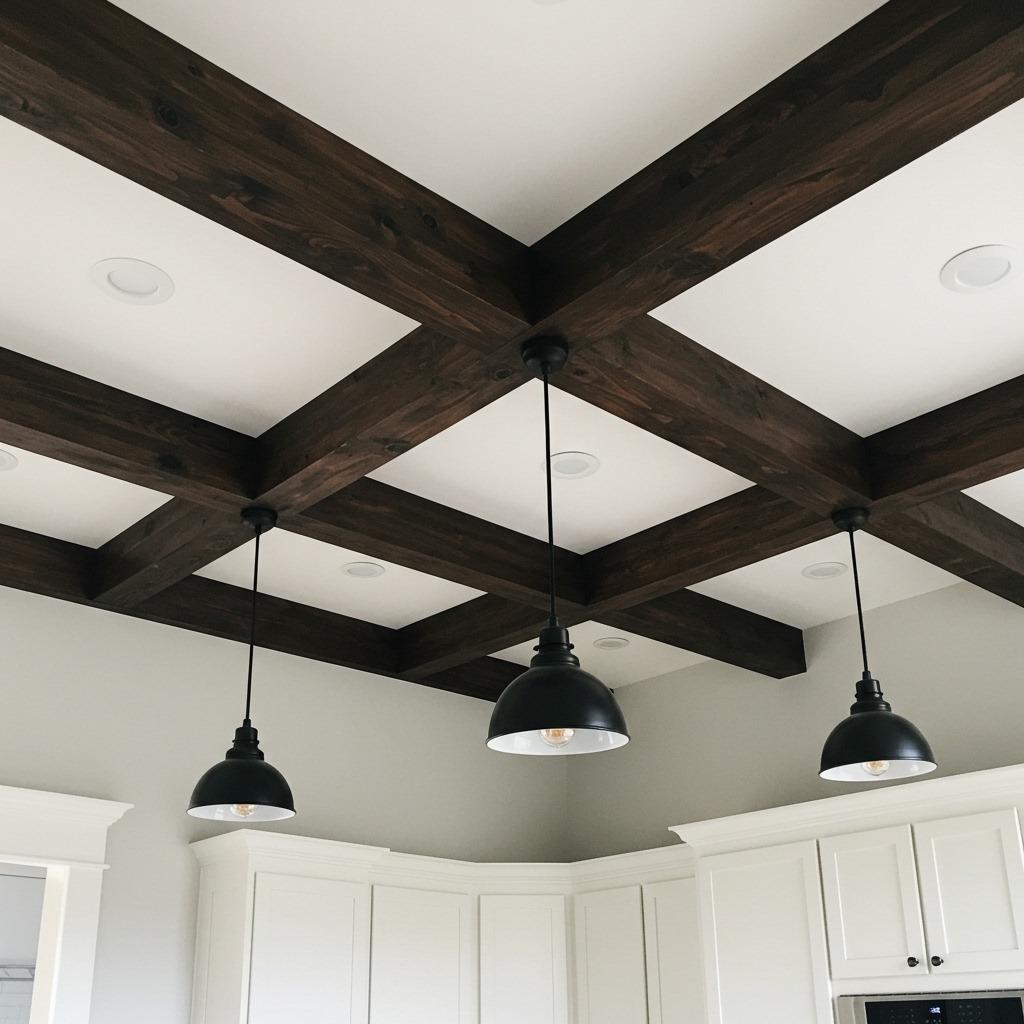
Ceiling beams bring architectural weight to a modern farmhouse kitchen. Whether they’re structural or decorative, these horizontal elements draw the eye upward and make standard-height ceilings feel more substantial. Dark-stained beams create dramatic contrast against white ceilings, while lighter finishes maintain an airier feel.
Real reclaimed beams bring authentic character but can be expensive and require structural considerations. Faux beams made from lightweight materials offer a convincing alternative at a fraction of the cost and weight. You can install them yourself in a weekend if you’re moderately handy.
Consider how your lighting interacts with beams. Pendant lights hanging between beams create rhythm and balance. Smart home improvement includes thinking about how these permanent features will work with both natural and artificial light throughout the day.
7. Industrial Pendant Lighting Over Island
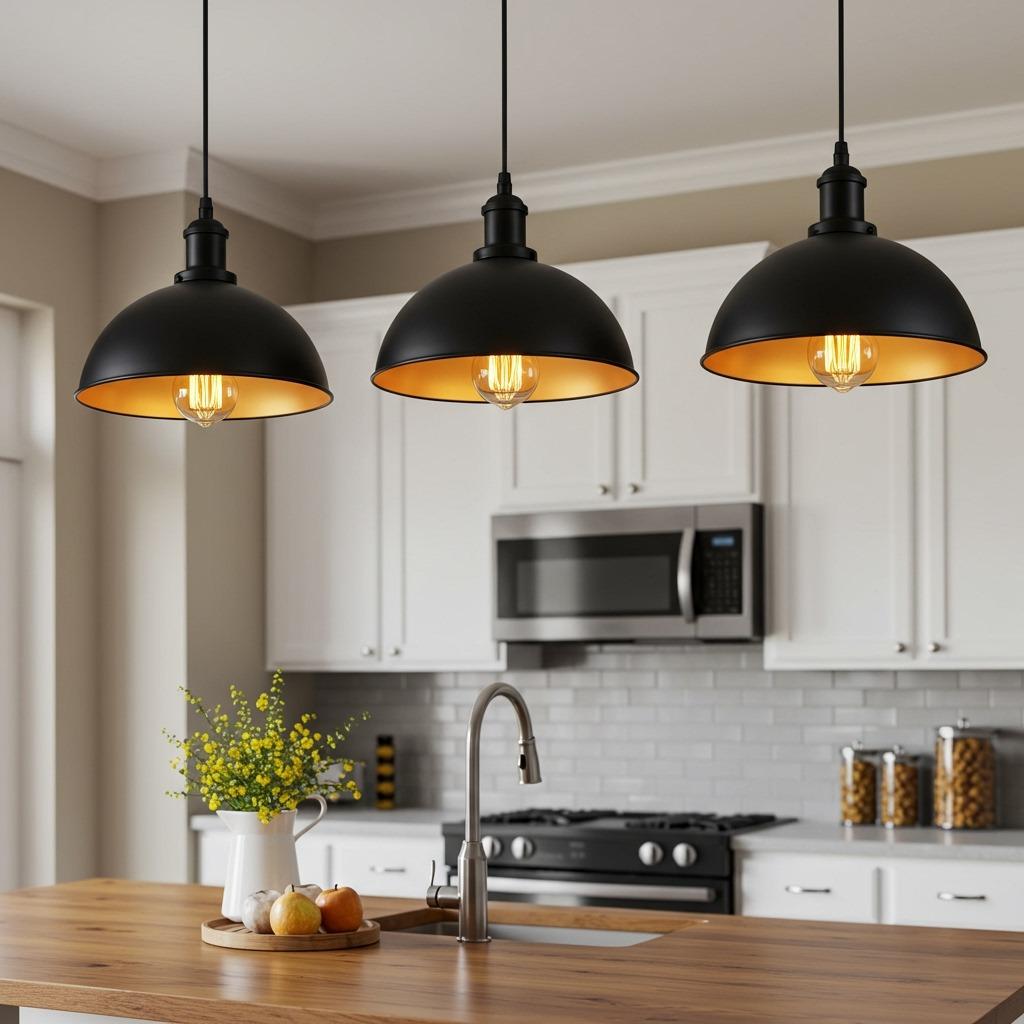
The right pendant lights can shift a kitchen from ordinary to intentional with surprising speed. Industrial-style pendants with metal shades bring a hint of warehouse cool to balance out farmhouse sweetness. Black metal domes, wire cages, or schoolhouse glass all work beautifully in this context.
Height matters more than most people realize. Pendants should hang low enough to illuminate your workspace but high enough that you’re not dodging them when you reach across the island. A good rule of thumb is 30-36 inches above the countertop, but adjust based on your ceiling height and sight lines.
Don’t feel locked into matching fixtures. Three similar-but-not-identical pendants can actually look more curated than a matched set. Mix finishes or shapes while keeping a common element like scale or era. This is where you can inject personality into what might otherwise feel too coordinated.
8. Open Shelving Display for Everyday Dishes
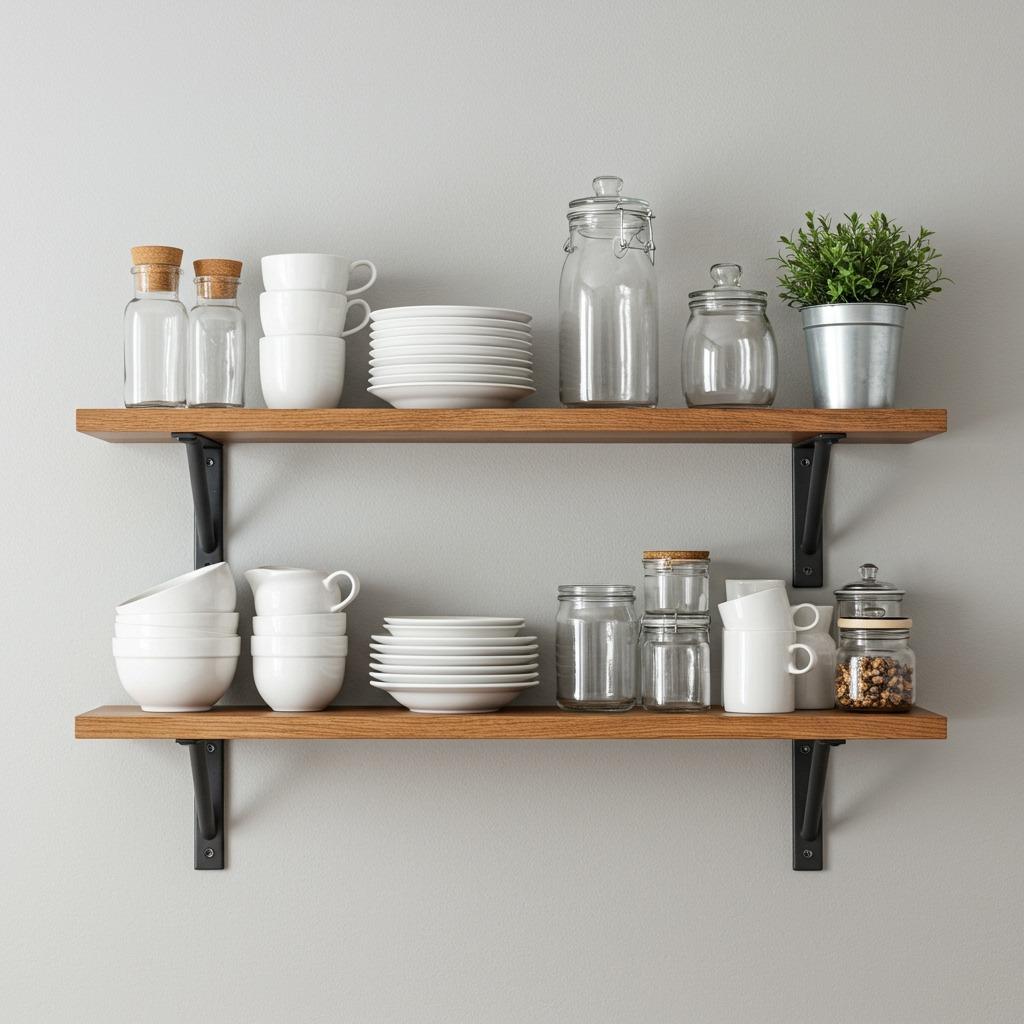
Open shelving forces you to be more intentional about what you keep on hand. That’s actually a benefit – it encourages editing your dish collection down to pieces you truly use and love. White dishes, clear glass storage, and the occasional vintage find create a curated look that feels both practical and decorative.
The key is restraint. Overstuffed shelves read as cluttered rather than charming. Leave breathing room between items, and think about varying heights and shapes for visual interest. Stack plates, line up mugs, tuck in a small plant or wooden cutting board.
Maintenance is the trade-off for this look. Your everyday dishes will collect dust and cooking grease more readily than if they were behind cabinet doors. A quick wipe-down when you’re doing dishes becomes routine. If this sounds like too much upkeep, consider open shelving for less-used items in a dining area rather than right next to the stove.
9. Subway Tile Backsplash With Dark Grout
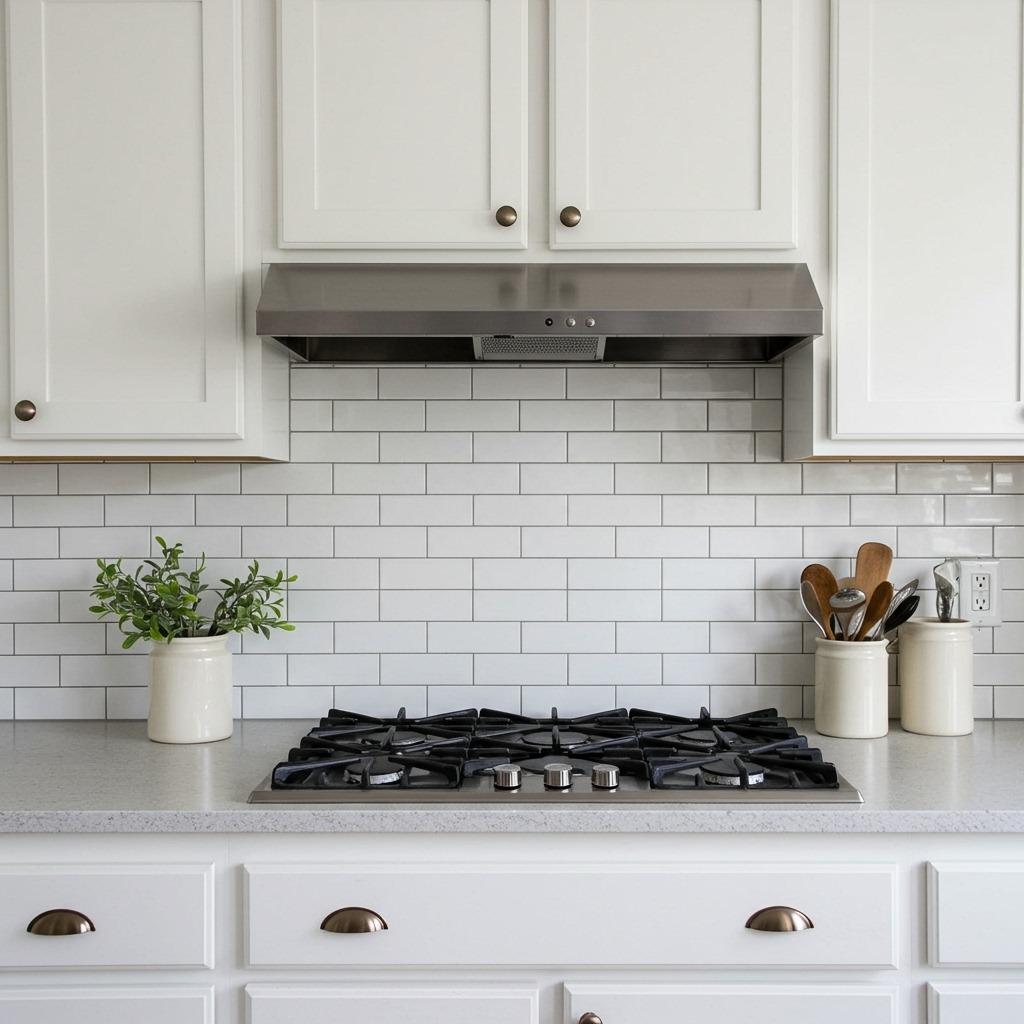
White subway tile is timeless for good reason. The 3×6 inch proportions work in kitchens of any size, the glossy surface reflects light beautifully, and the price point is typically reasonable. What elevates this from basic to distinctive is your grout choice. Dark gray or even black grout creates a grid pattern that adds graphic interest without introducing new colors or materials.
Installation pattern matters too. The classic brick or running bond pattern is most common, but you could try vertical stacking, herringbone, or vertical running bond for a different feel. Each creates slightly different visual movement across your wall.
One practical consideration: darker grout hides stains better than white, which seems counterintuitive but holds true in busy kitchens. That said, it will highlight any gaps or uneven grout lines, so installation quality matters. This is one element where professional installation might be worth the investment if you want crisp, consistent lines.
10. Reclaimed Wood Floating Shelves
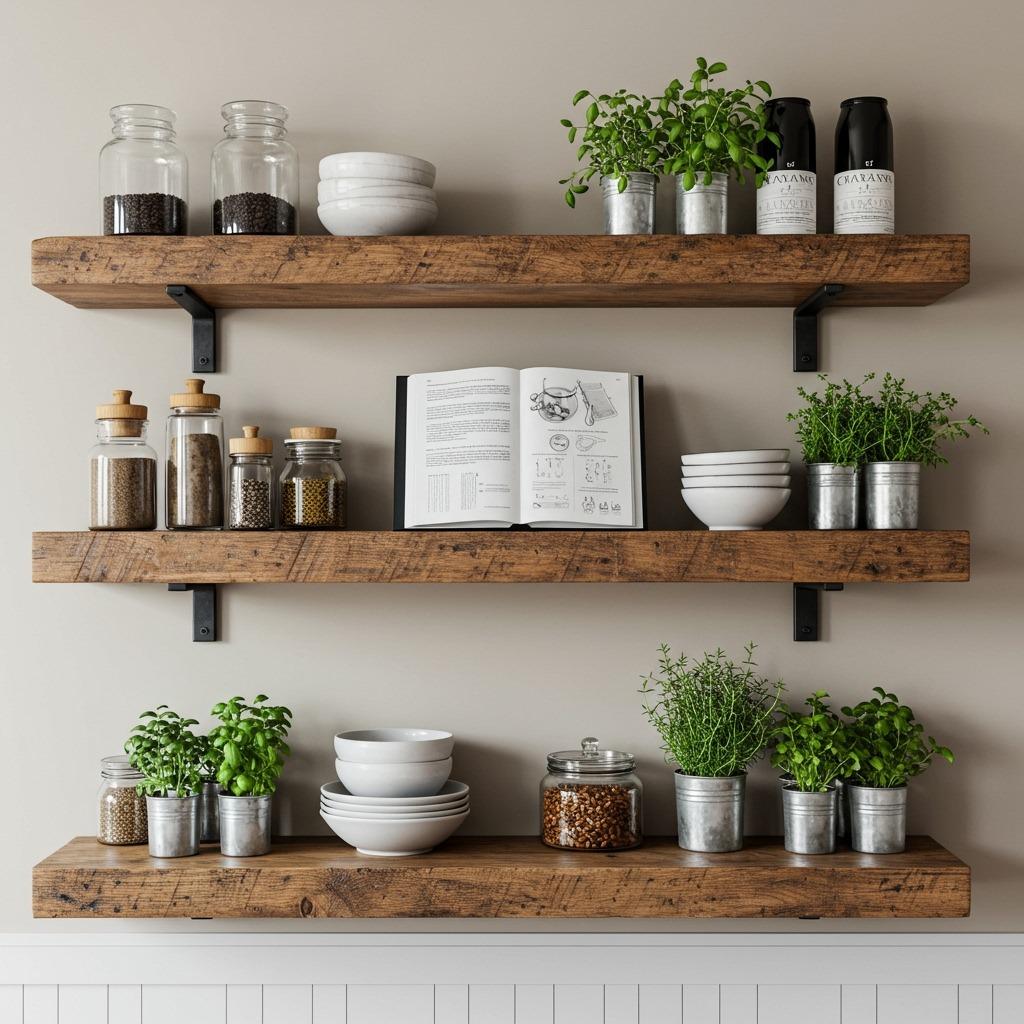
Reclaimed wood brings instant history into your kitchen. The weathered texture, nail holes, and color variation tell stories of the wood’s previous life – whether that’s a barn beam, factory floor, or old fence post. As floating shelves, these pieces become functional sculpture.
The thickness of reclaimed wood gives these shelves substantial presence. They don’t look like they’re trying to disappear into the wall; they’re meant to be noticed. This works beautifully in modern farmhouse design, where the tension between old and new creates interest.
Sourcing authentic reclaimed wood takes effort. Salvage yards, demolition companies, and specialty suppliers all offer options, though expect to pay premium prices for quality pieces. If budget is tight, you can achieve a similar aesthetic with new wood that’s been distressed and stained, though it won’t have quite the same character. Either way, proper installation is critical – these heavy shelves need secure anchoring into studs.
11. Mix of Wood Tones Throughout the Space
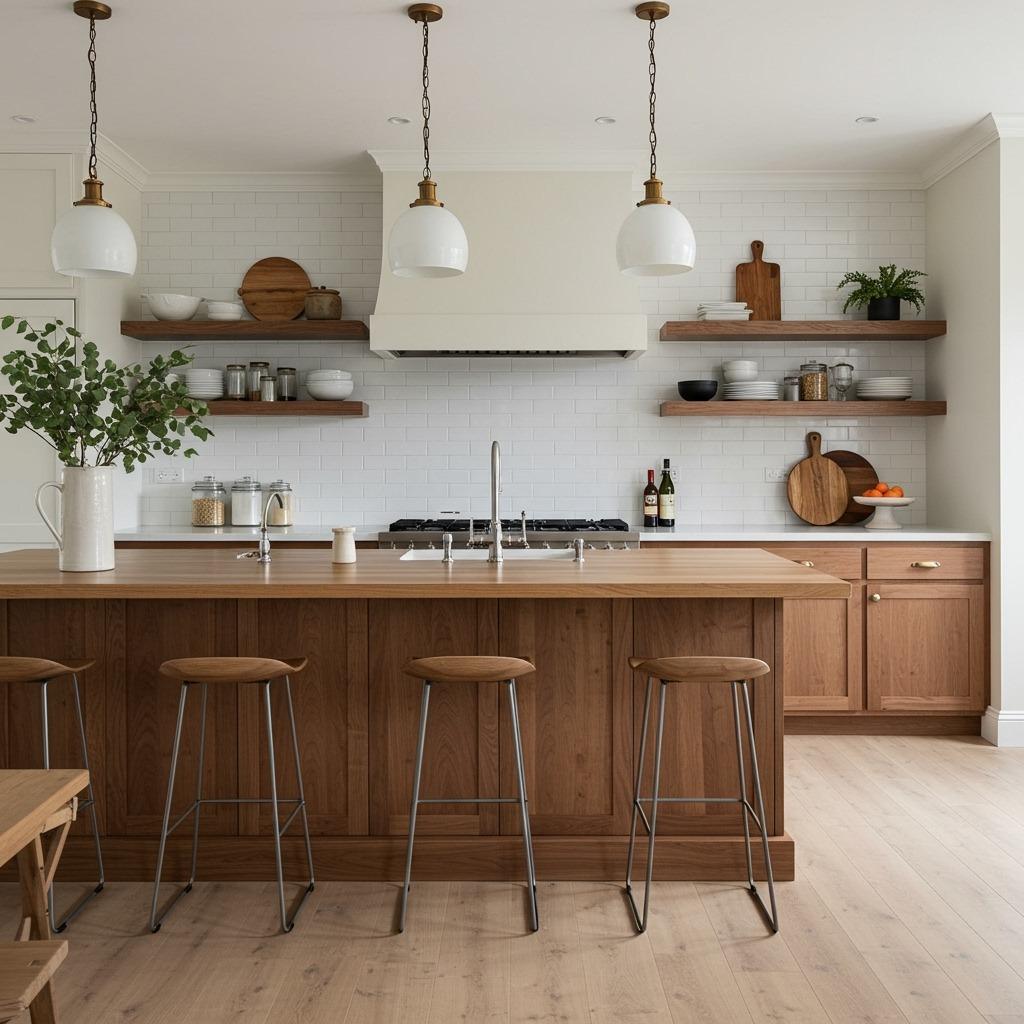
There’s an outdated rule that says all wood in a room should match. Modern farmhouse style proves this wrong delightfully. Mixing wood tones adds depth and keeps the space from feeling too matchy-matchy or showroom-perfect. Your floor might be light oak, your island topped with medium-toned butcher block, and your shelves made from darker reclaimed barn wood.
The trick is intention. Random wood tones look confused; varied but complementary tones look collected over time. Keep undertones consistent (all warm or all cool) and ensure each wood tone appears at least twice somewhere in the space for balance. Your cutting boards, bar stools, and even picture frames can help tie different tones together.
This approach also makes renovating in stages more manageable. You don’t need to replace everything at once to achieve a cohesive look. Adding a new wood element that bridges existing tones creates continuity while refreshing the space.
12. Vintage-Inspired Appliances in Modern Finishes
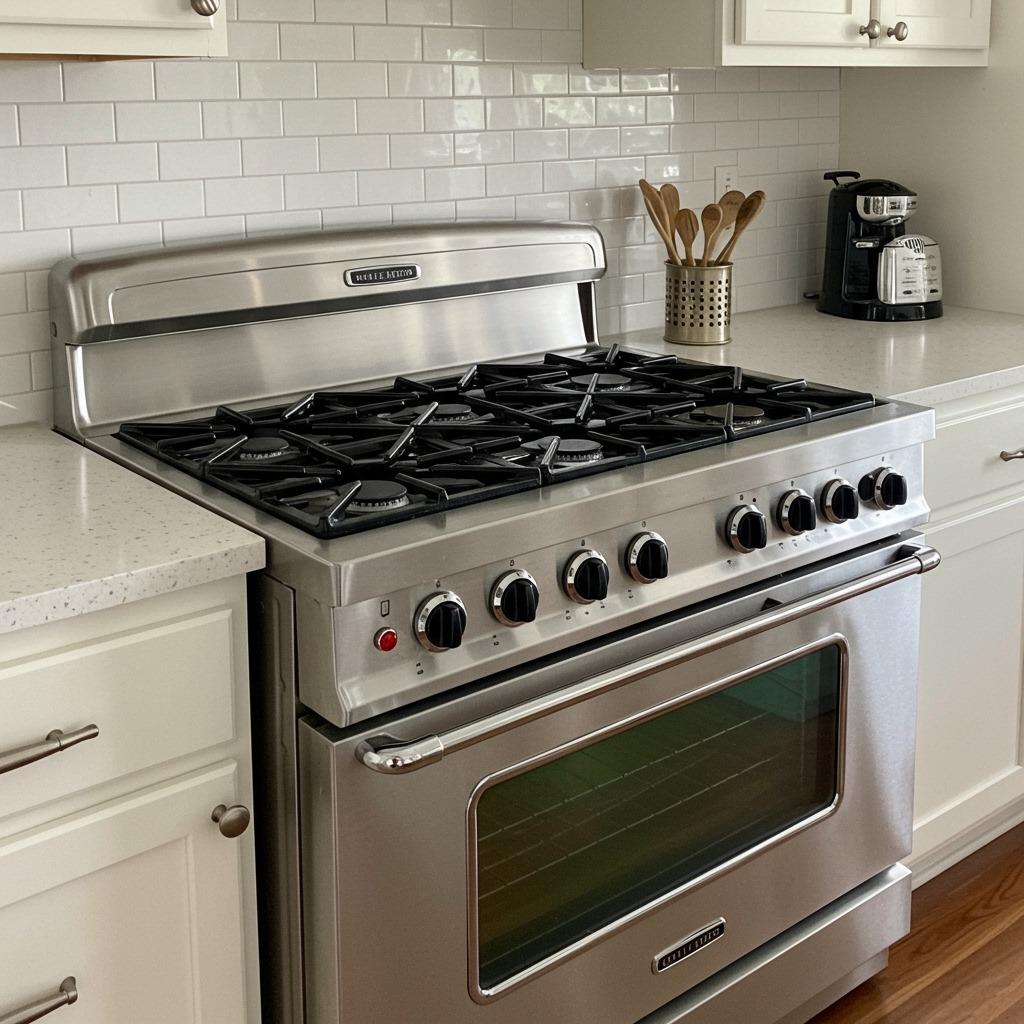
Big Chill, Smeg, and other manufacturers now offer appliances that blend vintage silhouettes with modern performance. These pieces become instant focal points – think curvy refrigerators that nod to 1950s design or ranges with retro knobs and modern convection ovens inside. The style reads farmhouse without feeling like you’re living in a museum.
Stainless steel finishes keep these pieces from skewing too cutesy. You get the charming shape but in a material that feels current and pairs well with contemporary fixtures. Some brands also offer matte white or black if you want a softer look.
The investment is significant – these specialized appliances cost more than standard models. But they also make a statement that standard appliances simply can’t. If you’re committed to the aesthetic and plan to stay in your home for years, they might be worth the splurge. Otherwise, focus your budget on elements that deliver more impact per dollar spent.
13. Large-Scale Farmhouse Table as Dining Space
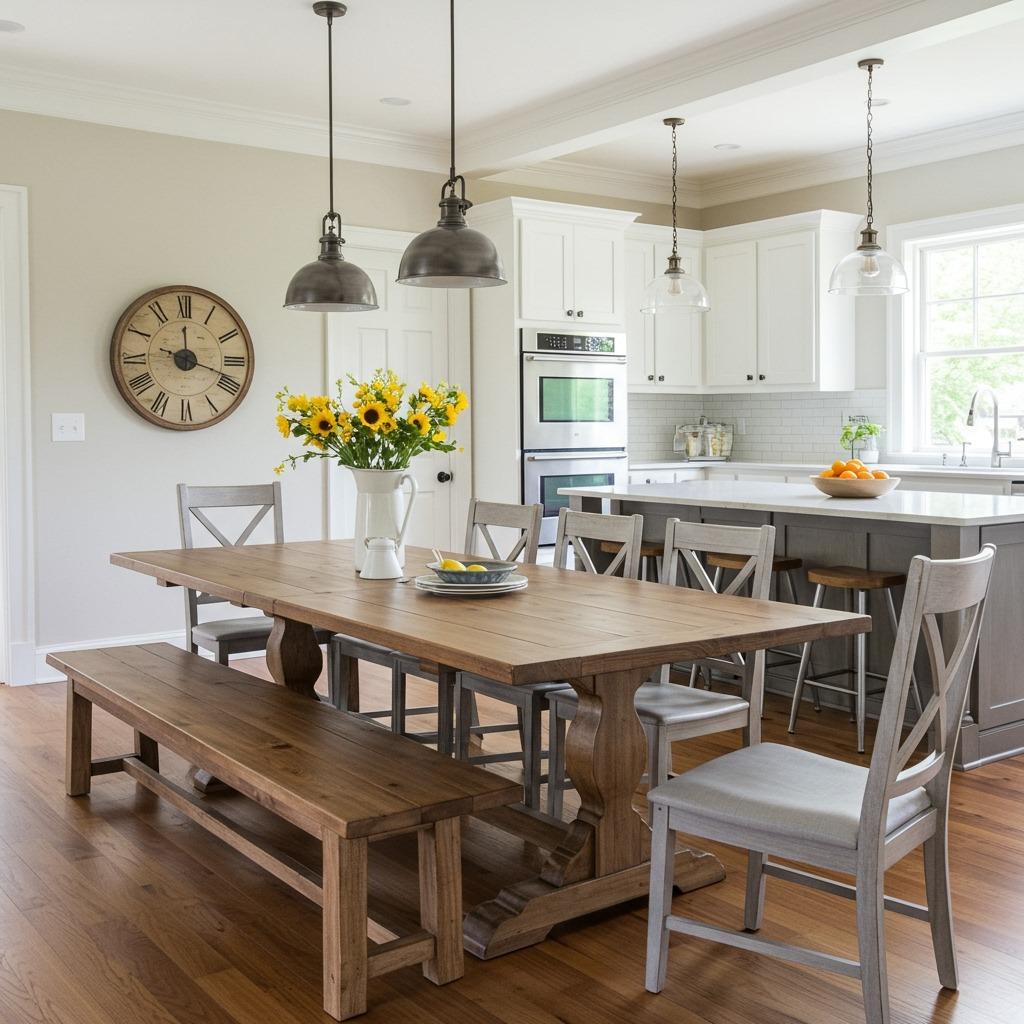
A substantial farmhouse table grounds your kitchen dining area with both function and presence. These tables are meant for gathering – wide enough that serving platters can sit comfortably in the center while everyone has elbow room, long enough to accommodate extra guests without folding leaves or extensions.
Solid wood construction is traditional, though you can find convincing reproductions with wood veneer tops at lower price points. Look for chunky turned legs or trestle bases that won’t wobble under daily use. Natural finish or distressed paint both work, depending on whether you want rustic warmth or cottage freshness.
Seating around a farmhouse table doesn’t have to match. A bench on one side maximizes seating and tucks neatly under the table when not in use. Mix chair styles for an collected-over-time look that feels more genuine than a dining set. This flexibility also makes it easier to find pieces that fit your budget and style as you go.
14. Woven Texture Through Baskets and Textiles
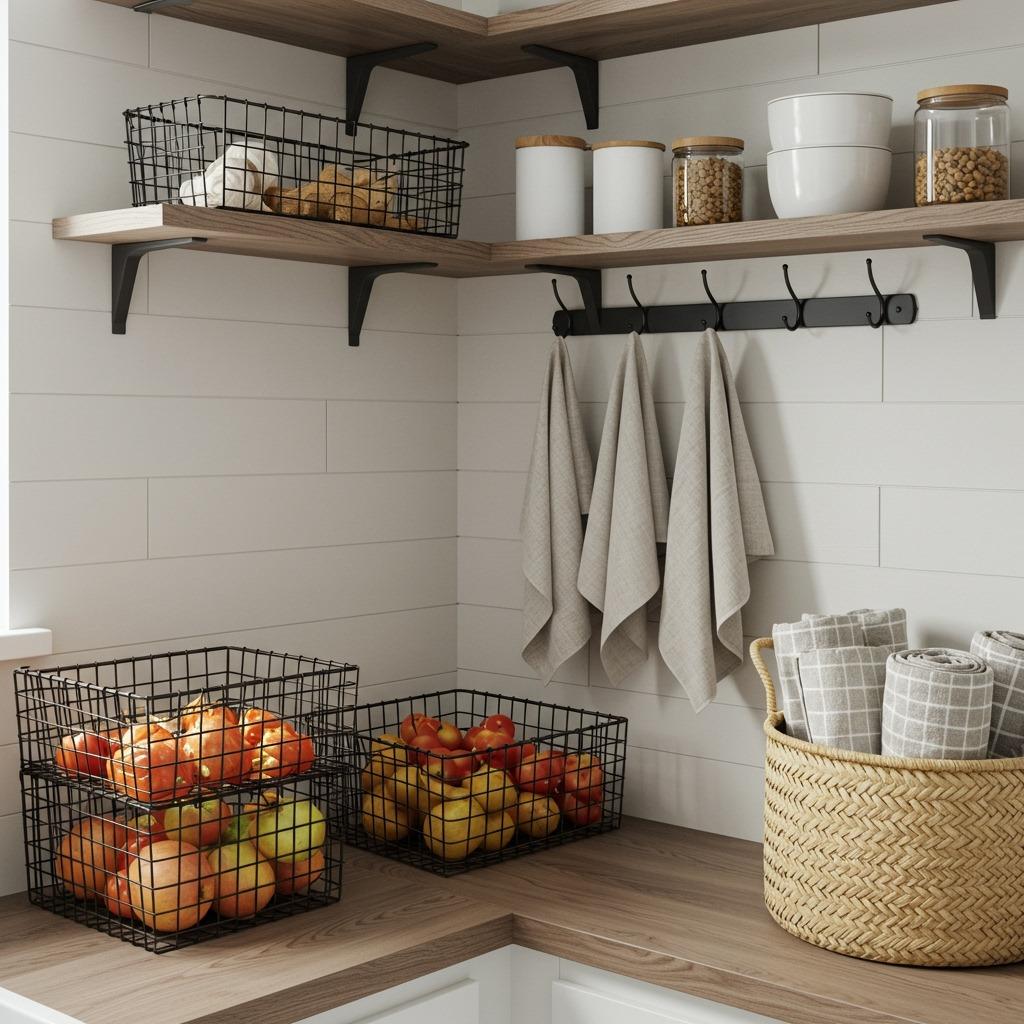
Woven elements soften all those hard surfaces in your kitchen. Baskets for produce storage, placemats at the table, roman shades in linen – these organic textures add warmth without
adding color. They’re also incredibly practical, which is very much in keeping with farmhouse sensibility.
Wire baskets have a vintage industrial feel that bridges rustic and modern. They work beautifully for storing onions and potatoes in a pantry or corralling kitchen linens on open shelves. Seagrass or wicker baskets suit similar purposes with a softer aesthetic. The key is keeping them functional rather than purely decorative – baskets that actually work earn their keep in a busy kitchen.
Natural linen or cotton towels draped from hooks or hanging from your oven handle contribute texture too. Skip the bright graphics or heavy patterns in favor of simple stripes, checks, or solid neutral tones that won’t compete with your overall design scheme.
15. Windows Above Sink With Simple Treatments
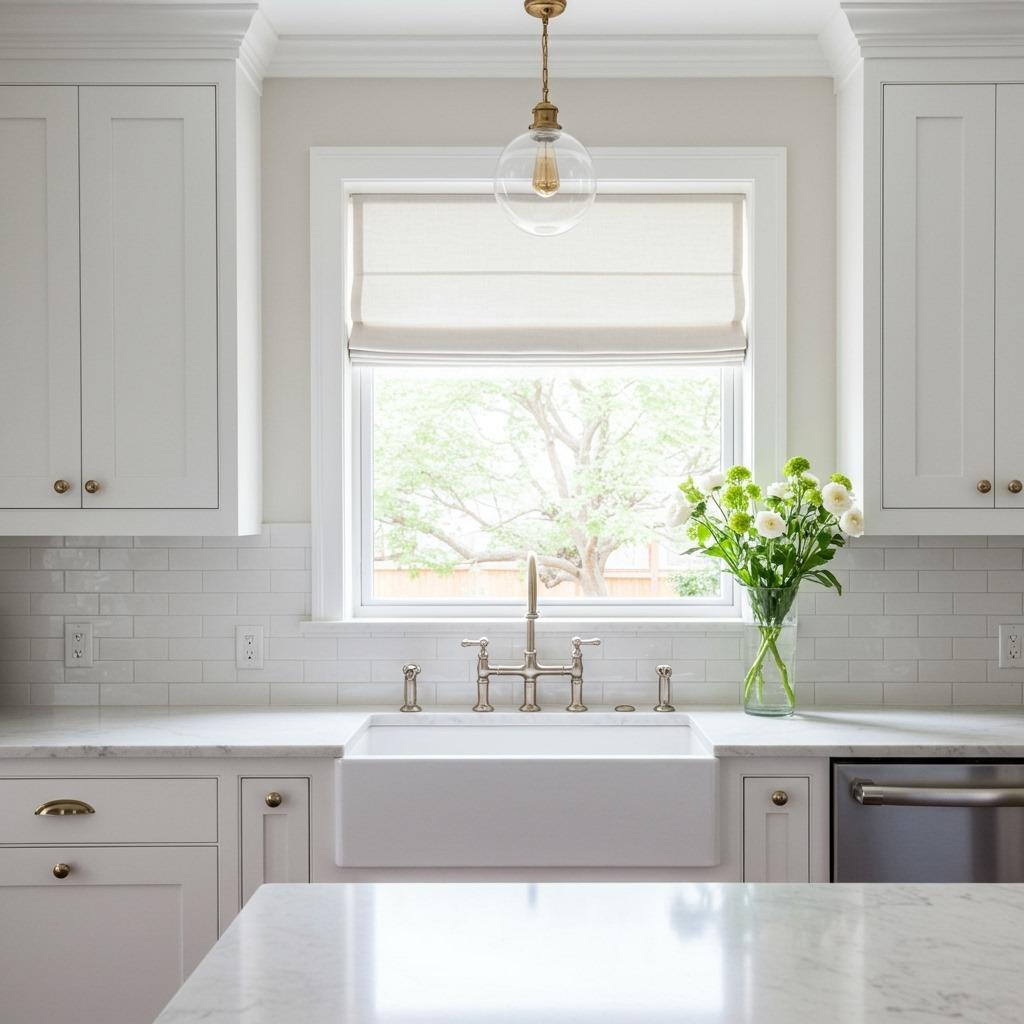
A window over your sink makes dishwashing almost meditative. Natural light, a view of your yard or garden, maybe birds at a feeder – it transforms a chore into something more pleasant. In modern farmhouse design, these windows are typically left simple, with minimal treatments that don’t block light.
Roman shades in natural linen offer privacy when needed but pull up completely out of the way during the day. Simple cafe curtains cover just the lower half of the window if you need screening from neighbors. Some people skip treatments entirely, especially if privacy isn’t a concern.
The window itself becomes a display opportunity. A narrow shelf might hold small potted herbs or a collection of vintage bottles. Just keep it minimal – you don’t want to block light or create clutter in this hardworking zone.
16. Painted Wood Plank Ceiling
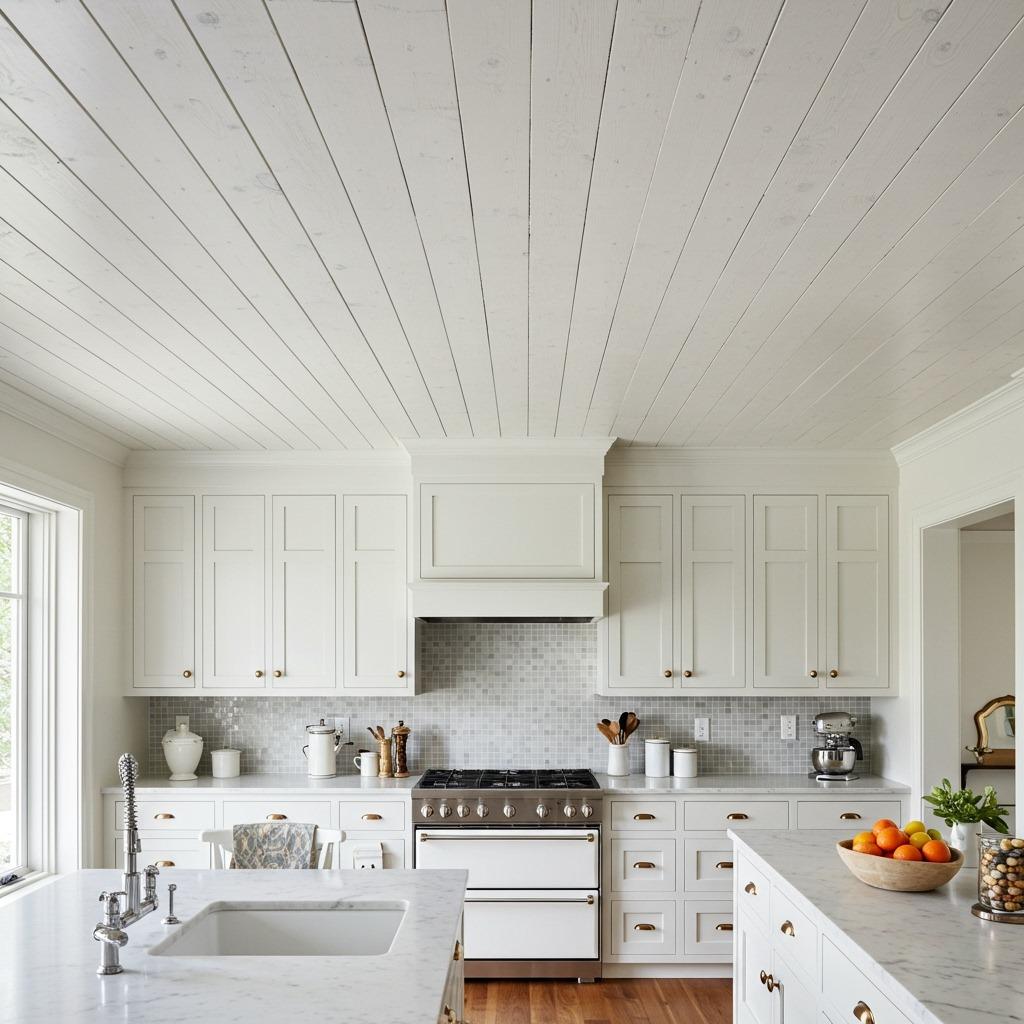
Taking your farmhouse aesthetic overhead creates an enveloping, finished feeling that drywall alone can’t match. Painting wood planks white keeps the look fresh rather than rustic, and the linear pattern adds subtle visual interest without demanding attention. This works especially well in kitchens with lower ceilings, where the horizontal lines create an illusion of greater width.
Tongue-and-groove pine is affordable and relatively easy to install if you’re comfortable with basic carpentry. The planks can go directly over existing drywall in many cases, though check your local codes. Painting before installation saves time and reduces drips, though you’ll need to touch up nail holes afterward.
This treatment pairs beautifully with exposed beams if you want more drama, or works solo for a cleaner Scandinavian-farmhouse hybrid look. The key is keeping the paint color consistent with your ceiling rather than introducing a new tone that chops up your vertical space.
17. Sliding Barn Door for Pantry or Dining Access
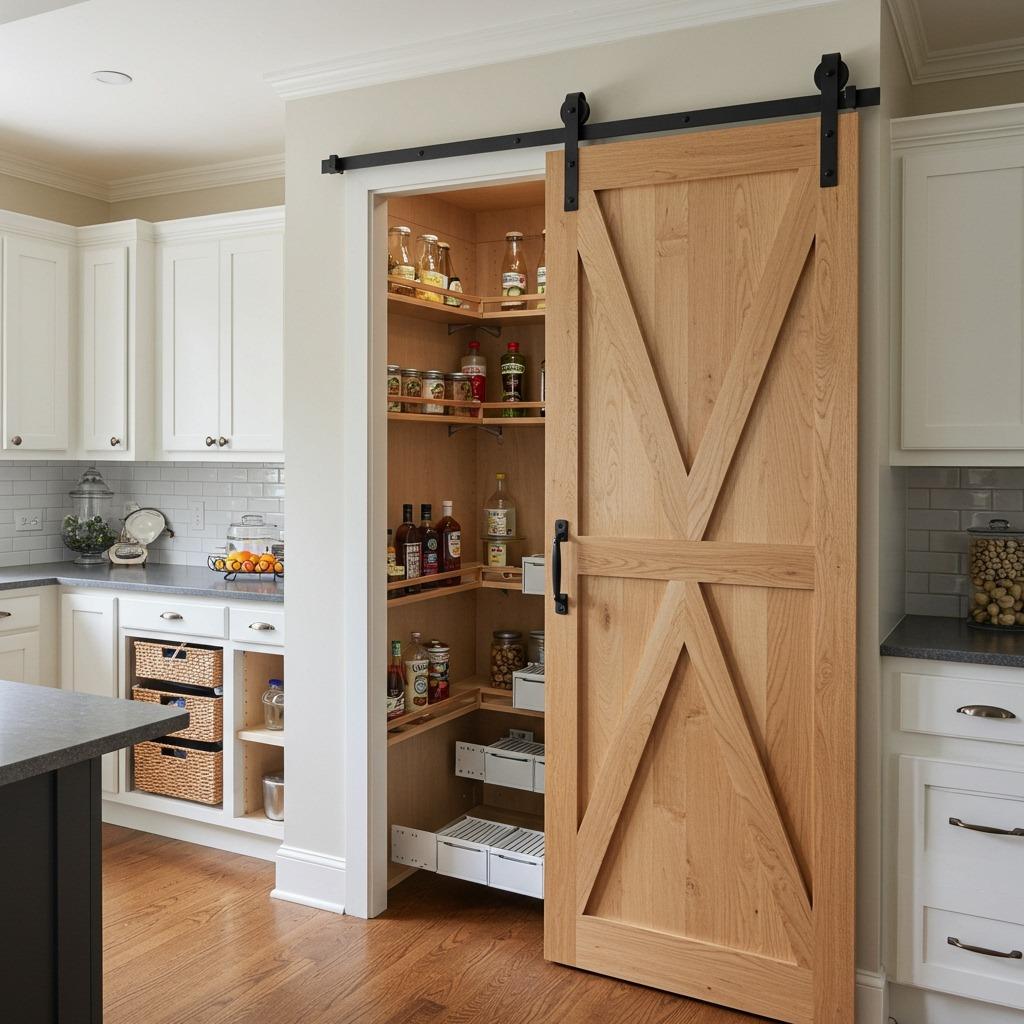
Sliding barn doors solve space issues while making a design statement. They work beautifully for pantries where a swinging door might block traffic flow, or as a divider between kitchen and dining areas when you want flexibility. The hardware is inherently farmhouse – those exposed rails and rollers reference actual agricultural buildings.
You can buy complete hardware kits online or at home improvement stores. The door itself can be new construction with a rustic finish, actual reclaimed wood, or even a vintage door from an architectural salvage shop. Black metal hardware feels most current, though oil-rubbed bronze offers a slightly softer look.
One practical consideration: barn doors slide along the wall rather than into it, so they’re always visible. Make sure you have adequate wall space and that the door’s location makes sense when open. Also, these doors don’t seal as tightly as traditional doors, so sound travels more freely between spaces. For a pantry that’s usually fine; for a more private space you might want traditional doors.
18. Natural Stone or Marble Countertops
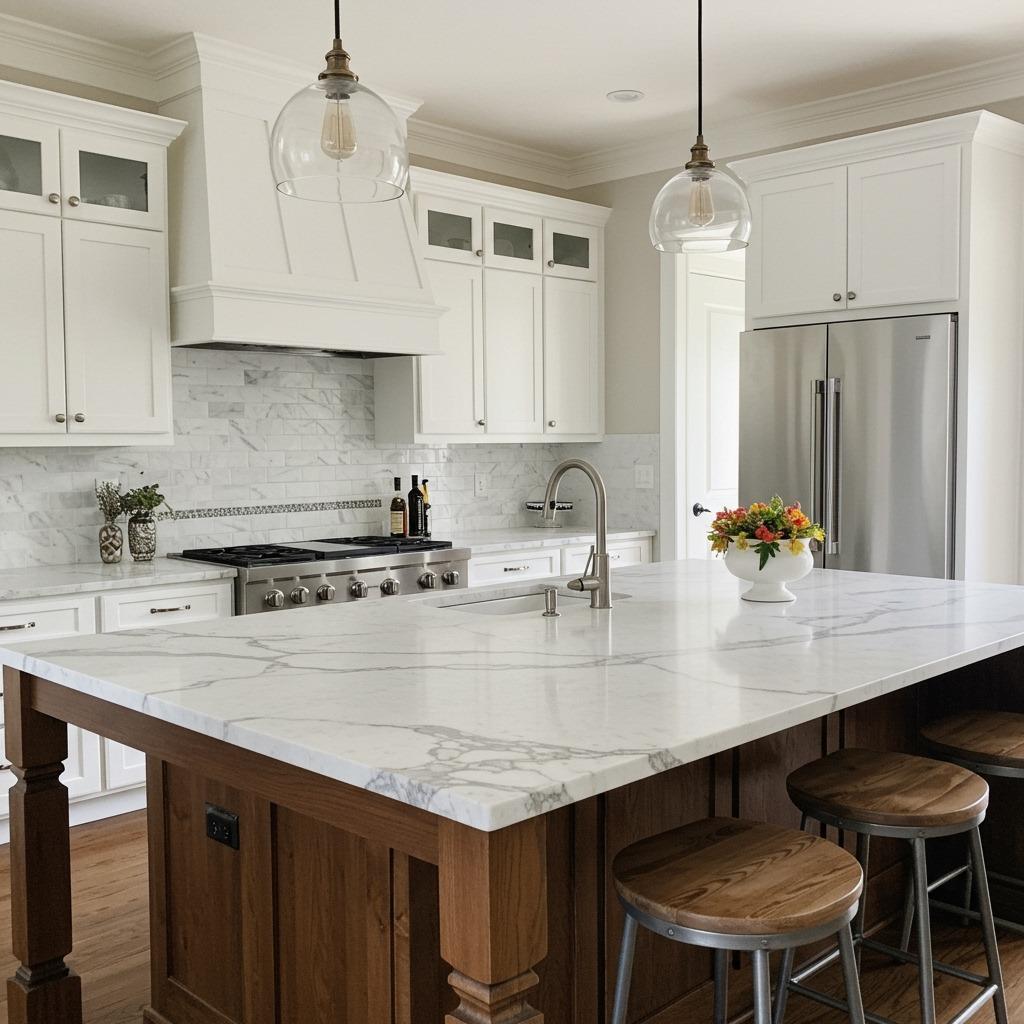
Natural stone countertops bring elegance to farmhouse kitchens without feeling too formal. White marble with gray veining is classic, though quartzite offers similar aesthetics with better durability. Soapstone provides deep gray-green tones that age beautifully, developing a patina that actually enhances character over time.
These materials aren’t without maintenance considerations. Marble can etch from acidic foods and liquids; soapstone needs regular oiling; granite requires periodic sealing. But many people appreciate how natural materials change and mark with use – it’s part of their story and appeal in a farmhouse aesthetic that values authenticity over perfection.
If you’re concerned about upkeep, consider using natural stone only on perimeter counters and choosing a more durable surface for your island where you do most of your food prep. This gives you the visual impact of stone while reserving your high-traffic workspace for something more forgiving like quartz or butcher block.
19. Gallery Wall of Vintage Kitchen Tools
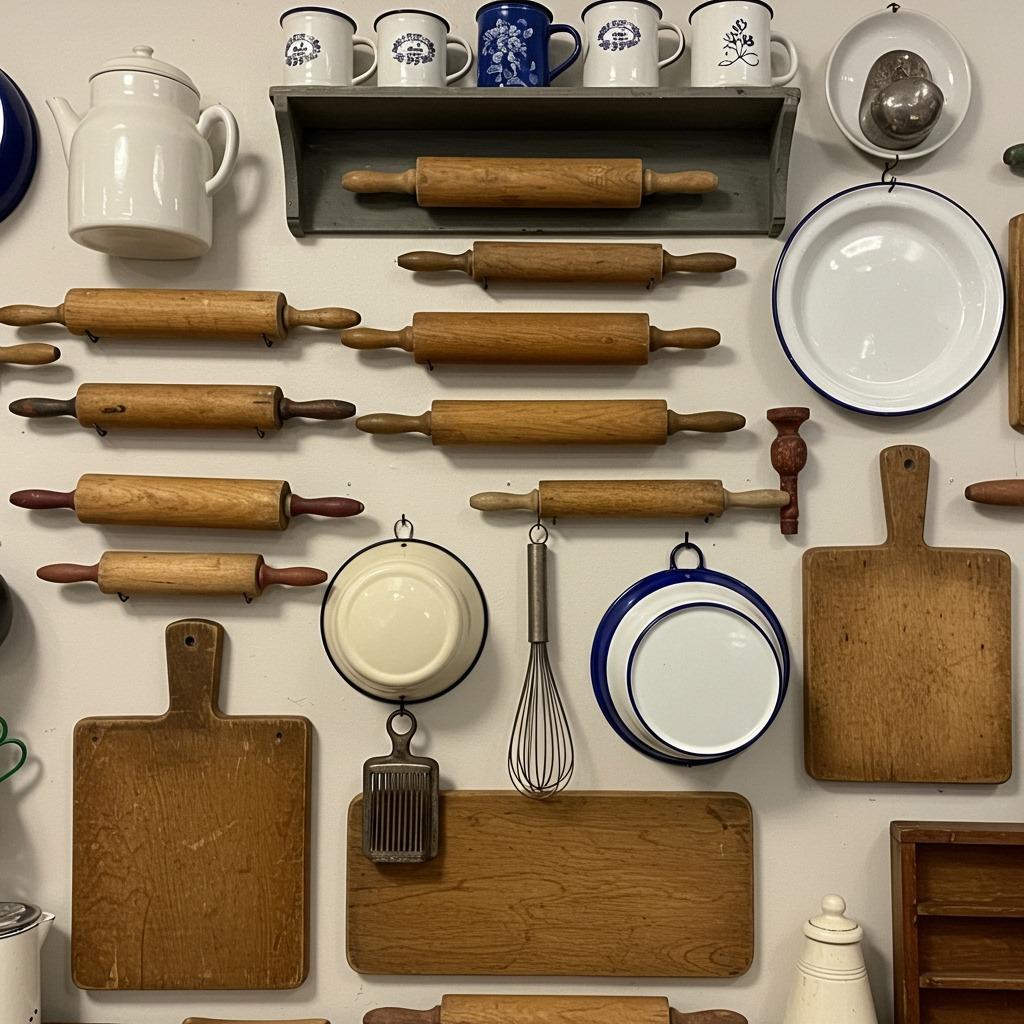
Collections tell stories, and vintage kitchen tools carry charm that new items simply can’t replicate. Wooden rolling pins with varying patinas, wire whisks with different gauge handles, enamelware pieces in cream or robin’s egg blue – arranged intentionally on a wall, they become functional art that reinforces your farmhouse theme.
The beauty of this approach is that you can build your collection over time. Thrift stores, estate sales, and antique shops all offer pieces at reasonable prices. Look for items with genuine age and wear rather than artificially distressed reproductions. Real patina has depth that manufactured aging never quite captures.
Arrangement matters as much as the items themselves. Odd numbers create better visual balance than even. Vary sizes and orientations – some pieces hung on hooks, others on small shelves or ledges, maybe one or two larger items anchoring the composition. Step back frequently while arranging to ensure the grouping feels cohesive rather than random. This same principle applies to creating an accent wall in any room of your home.
20. Oversized Kitchen Island With Seating
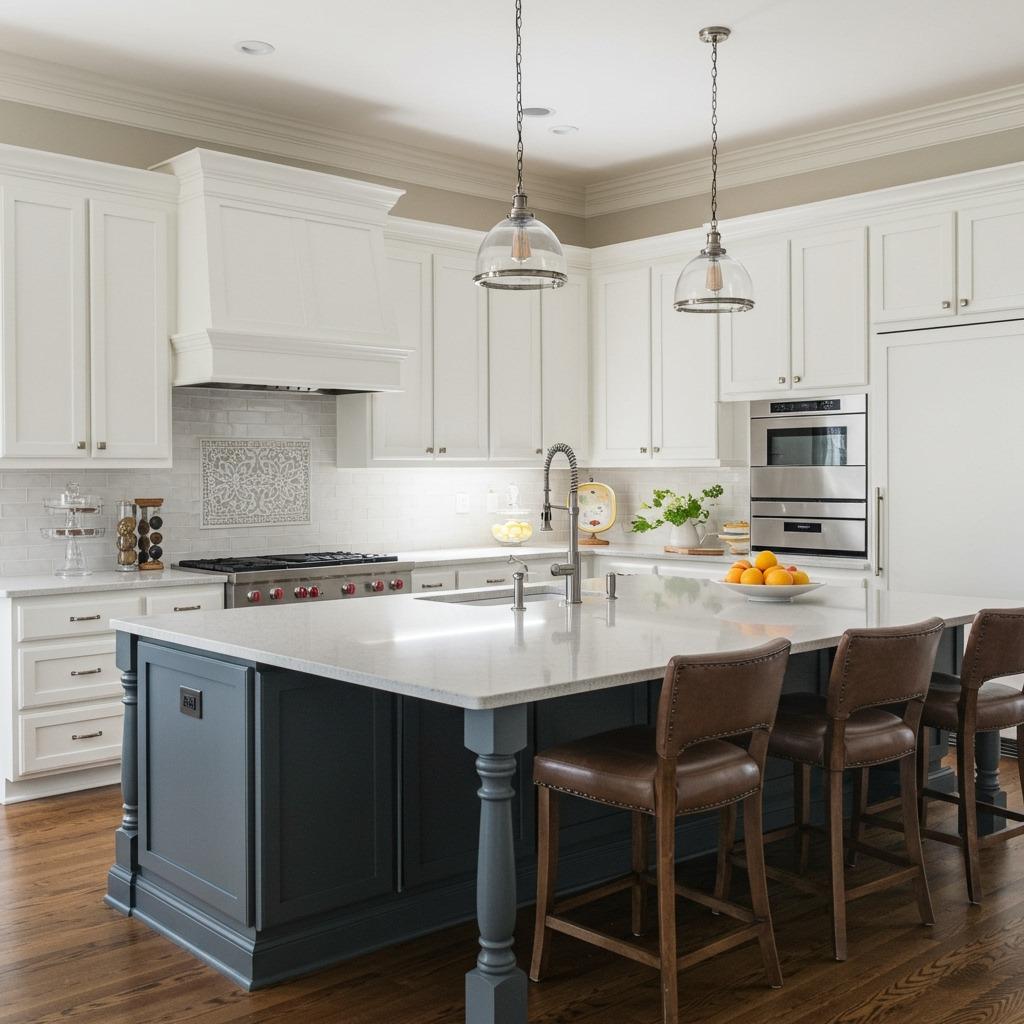
An oversized island transforms your kitchen into the true heart of your home. This isn’t just extra counter space – it’s where kids do homework while you prep dinner, where friends gather with wine glasses while you cook, where Sunday morning pancakes happen with everyone gathered around. Functionally, it’s invaluable. Aesthetically, it anchors your entire layout.
Size matters, but so does proportion. Your island should feel substantial without making the kitchen difficult to navigate. The standard recommendation is at least 36 inches of clearance around all sides for comfortable movement, though 42-48 inches is better if you have the space. The seating overhang should be 12-15 inches to allow comfortable knee room.
Think about storage too. An island with cabinetry below keeps cookware or serving pieces handy while hiding clutter. Some designs incorporate bookshelves on the dining side for cookbooks and decorative items. If you’re planning this in a small space renovation, you might opt for a smaller scale island or a rolling cart that provides flexibility.
21. Pot Filler Faucet Above Range
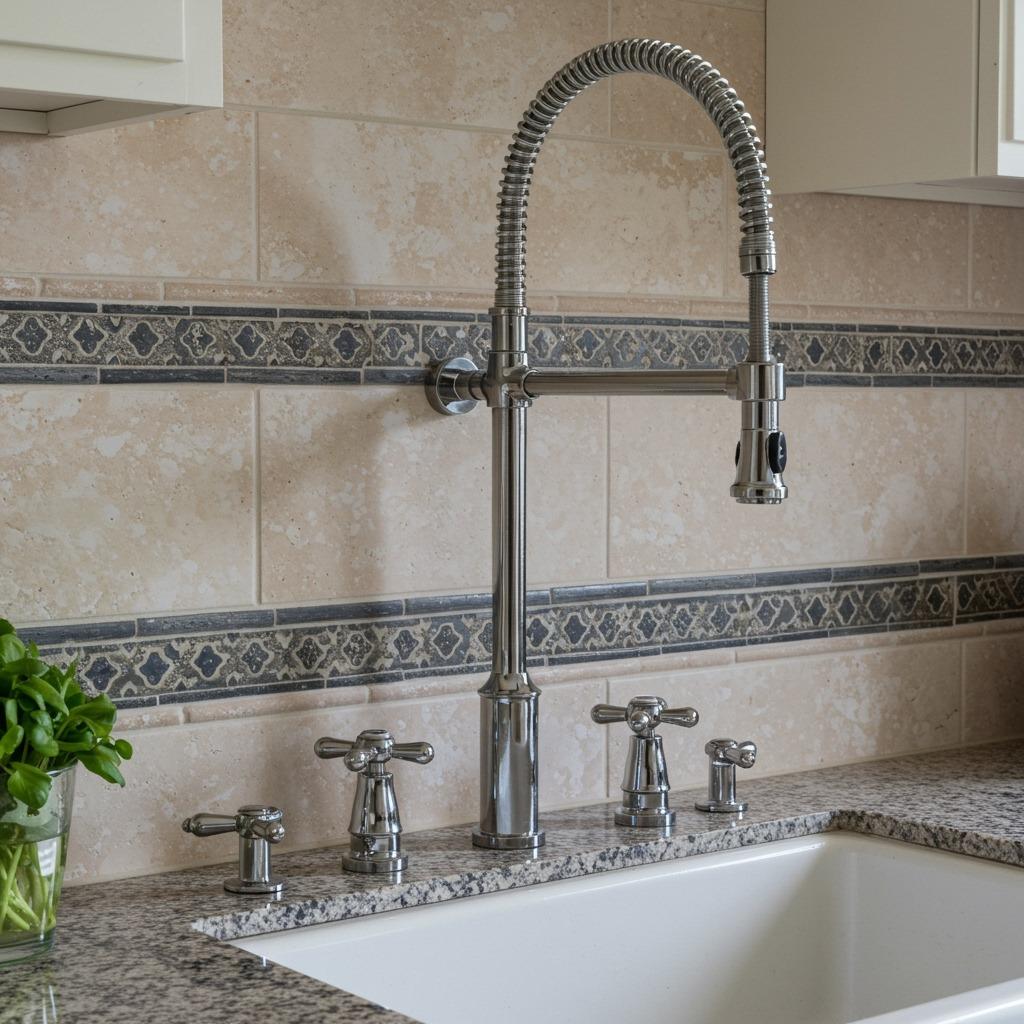
Pot filler faucets are undeniably practical – no more hefting heavy stockpots from sink to stove. But they’re also a subtle luxury detail that elevates your kitchen from everyday to something special. These wall-mounted faucets typically feature an articulating arm that extends over your burners when needed and folds back when not in use.
Finishes should coordinate with your main faucet and hardware. Polished chrome, brushed nickel, or matte black all work beautifully depending on your overall palette. Traditional cross handles feel most farmhouse, while lever handles offer easier operation with one hand.
Installation does require running a water line to your backsplash, so this is easier to incorporate during initial construction or major renovation. If you’re working with existing kitchens, the plumbing work can get expensive. That said, once installed, you’ll wonder how you ever managed without it. Just remember – pot fillers don’t have drains, so you’ll still need to carry filled pots from stove to sink if you change your mind.
22. Mix of Open and Closed Storage
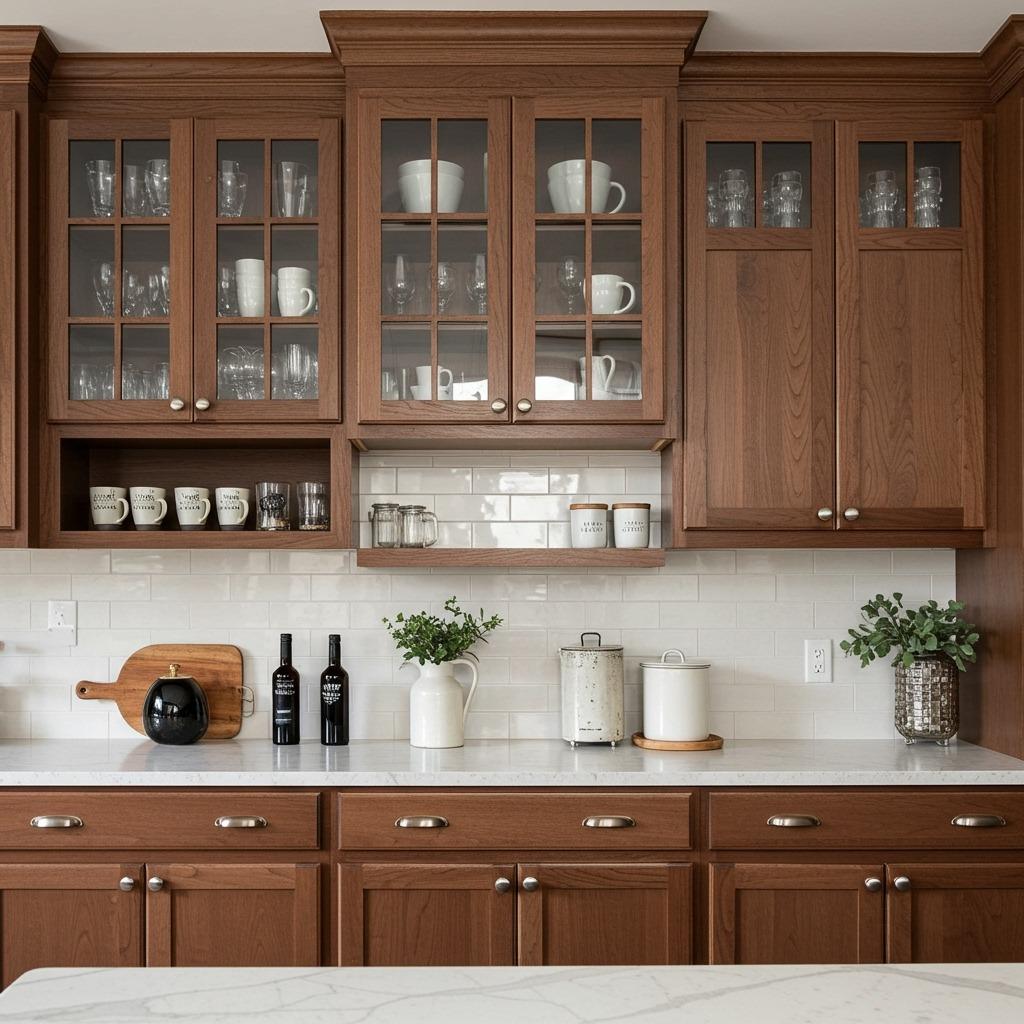
Balance is everything in kitchen storage. Too many closed cabinets can feel heavy and monotonous. Too much open storage becomes overwhelming and high-maintenance. The sweet spot is a thoughtful mix that gives you flexibility while maintaining visual interest.
Glass-front upper cabinets offer a middle ground between fully open and closed storage. You can display prettier items while keeping dust at bay. Consider this approach for cabinets flanking a window or range hood, where the glass reflects light and keeps sight lines open. Lower cabinets work better as solid doors since you’re storing less attractive items like trash bags and cleaning supplies down low.
Strategic open shelving breaks up cabinet runs and provides landing spots for everyday items or decorative pieces. The key is intentional placement – open shelves where you actually use the items stored there, closed cabinets for the overflow and occasional-use pieces. This practical approach to kitchen and dining ideas ensures your space works as hard as it looks good.
23. Rustic Wood Bar Stools
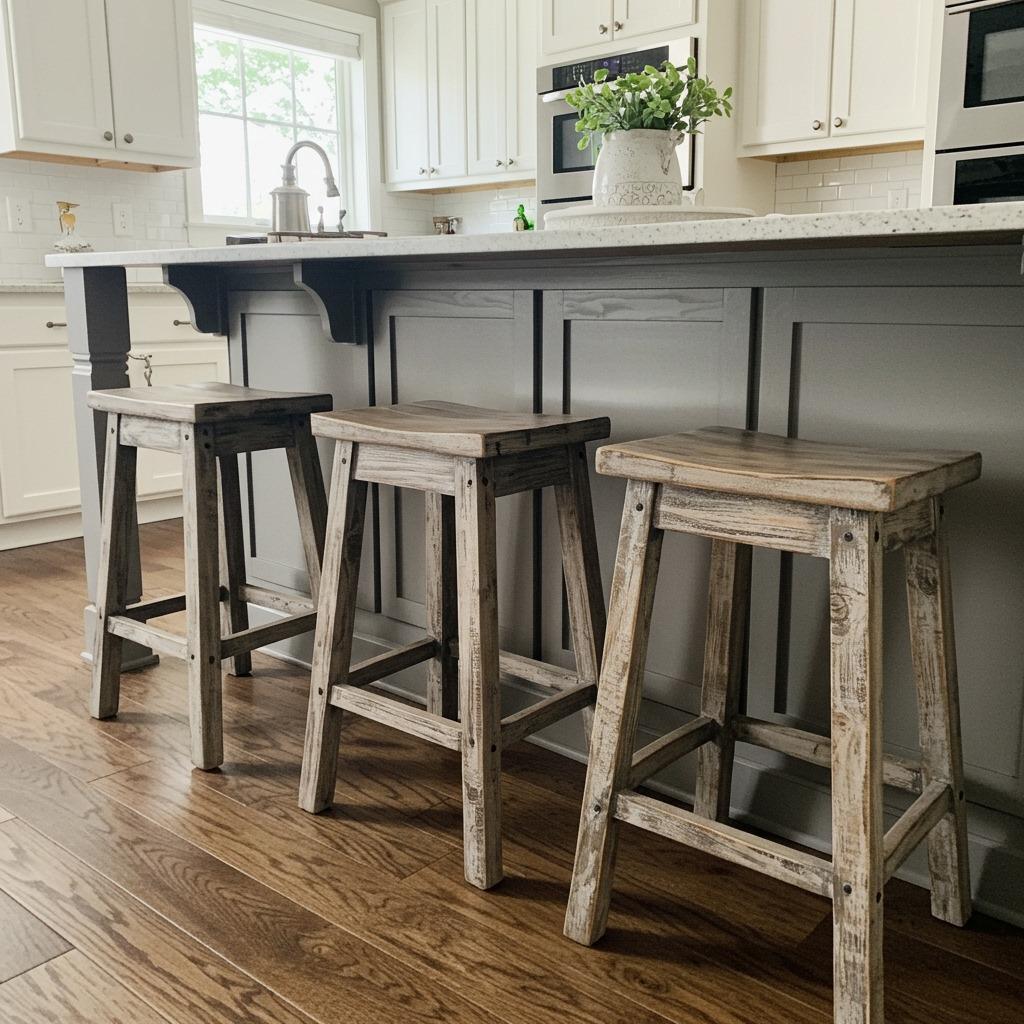
Bar stools might seem like an afterthought, but they’re actually significant design elements in modern farmhouse kitchens. You’re looking at them from every angle, and they help define whether your space feels finished or not quite pulled together. Wooden stools with simple lines and natural finishes reinforce your farmhouse aesthetic while providing comfortable seating.
Counter height (24-26 inches) or bar height (28-30 inches) depends on your island or counter height. Measure carefully – stools that are too tall or too short are uncomfortable and look awkward. Stools with footrests are generally more comfortable for extended sitting, which matters if your island is the gathering spot for morning coffee or homework sessions.
Backless stools tuck completely under counters for a cleaner look, but backs provide support for longer sitting. Swivel seats offer convenience, though some people find the motion annoying. Test-sit if possible, because comfort matters more than aesthetics when you’re actually using these daily. You can find beautiful options that check both boxes.
24. Pegboard Wall for Hanging Utensils and Pots
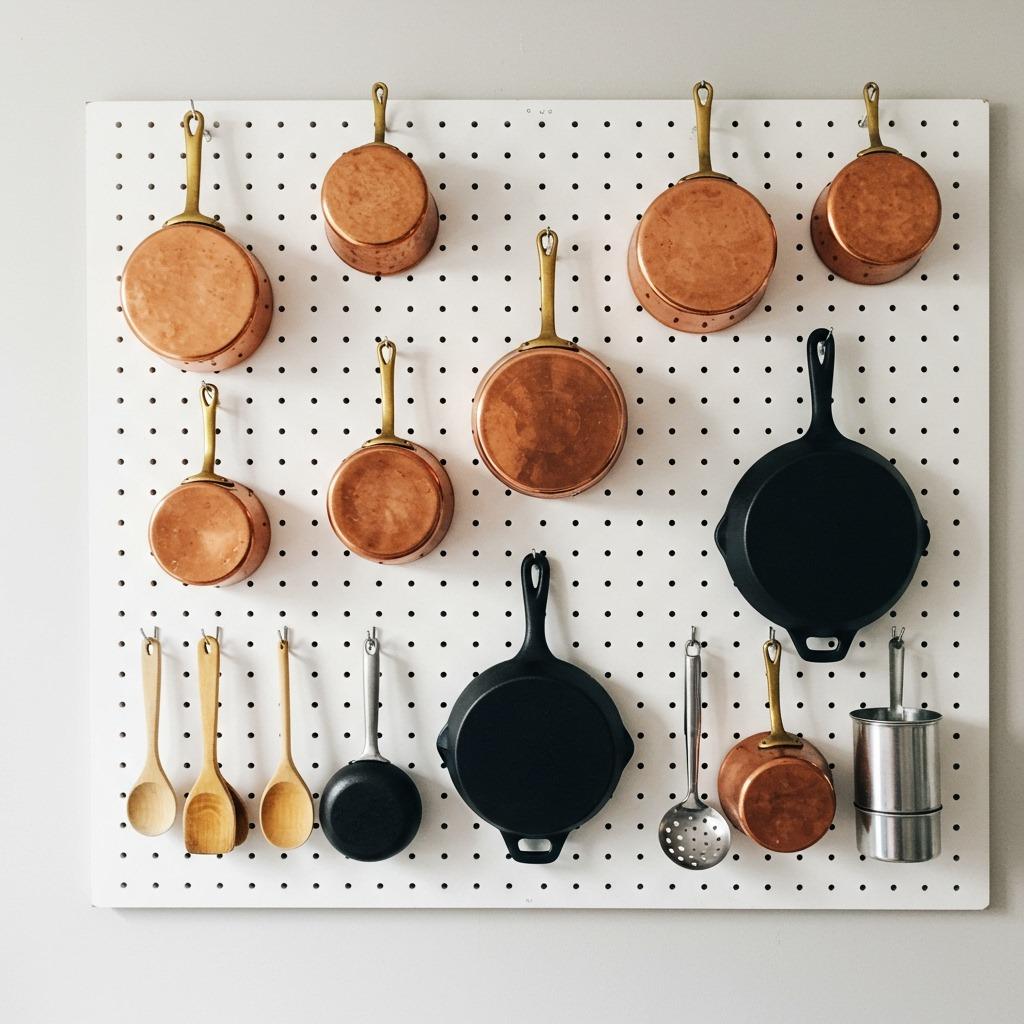
Pegboard isn’t just for garages anymore. In kitchens, it becomes a practical display system that keeps your most-used tools within easy reach while creating visual interest. The grid pattern has an honest, utilitarian quality that fits beautifully with farmhouse sensibility. Plus, the arrangement is completely customizable – move hooks and shelves as your needs change.
Paint your pegboard to integrate it with your kitchen rather than leaving it raw wood or that industrial beige. White keeps it fresh and lets your hung items stand out as the focal points. Black creates more drama if you want a modern edge. The key is treating it as an intentional design element rather than temporary storage.
Curate what you hang carefully. This isn’t about maximizing storage capacity; it’s about displaying tools that are genuinely beautiful and useful. Copper pots, cast iron skillets, vintage utensils, maybe a collection of enamelware – these items earn their wall space through both function and form. If something is purely practical but not pretty, it probably belongs in a drawer or cabinet instead.
25. Apothecary-Style Glass Jars for Dry Goods
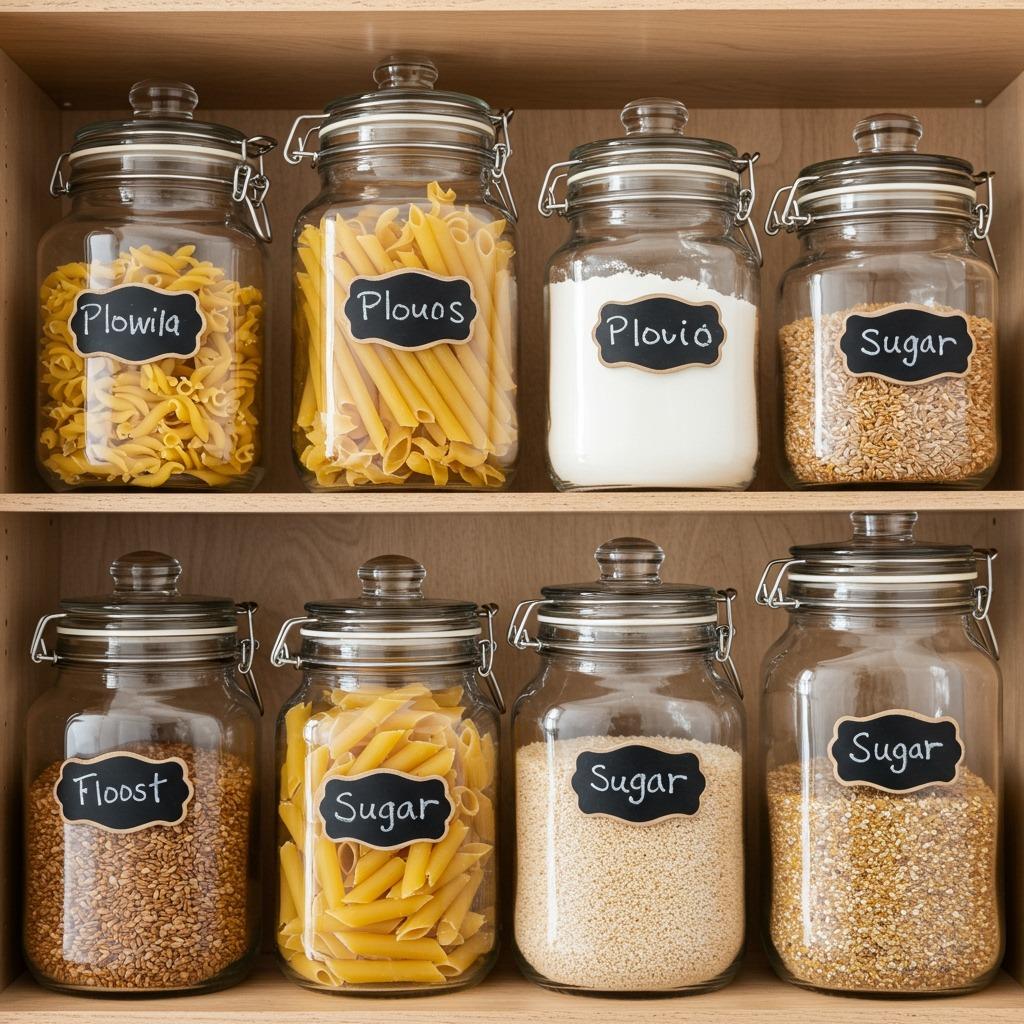
Clear glass storage containers transform your pantry into something that’s both functional and visually satisfying. Apothecary-style jars with sealed lids keep dry goods fresh while letting you see exactly what you have and how much remains. The uniformity of glass jars creates a sense of order that’s almost meditative to look at.
Proper labeling matters. Chalkboard labels offer flexibility since you can change them as contents change, though printed labels have a more permanent, collected look. Whichever you choose, keep your labeling style consistent across all containers for a cohesive appearance.
This approach does require transferring purchases into your containers rather than storing items in original packaging. Some people love this ritual; others find it tedious. Be honest about which camp you’re in before investing in a complete set of jars. You might start with a few containers for most-used items and expand if you find the system works for you.
26. Vintage Pendant Lights or Chandeliers

Lighting fixtures are jewelry for your kitchen, and vintage or vintage-inspired pieces bring personality that new fixtures sometimes lack. Whether it’s an authentic antique brass chandelier
over your dining table or reproduction schoolhouse pendants over your island, these fixtures become conversation pieces that anchor your design.
Authentic vintage fixtures offer unmatched character but may need rewiring for safety and code compliance. This adds cost and complexity but results in a truly unique piece. Reproduction fixtures give you vintage aesthetics with modern wiring and UL listings, plus you know you’ll receive two matching fixtures if you need a pair.
Scale these fixtures appropriately to your space. A chandelier shouldn’t overwhelm a small breakfast nook, but it should be substantial enough to anchor a larger dining area. The general rule is adding your room’s length and width in feet, then converting that to inches for chandelier diameter. So a 10×12 room could handle a 22-inch diameter fixture comfortably.
27. Two-Tone Cabinet Color Scheme
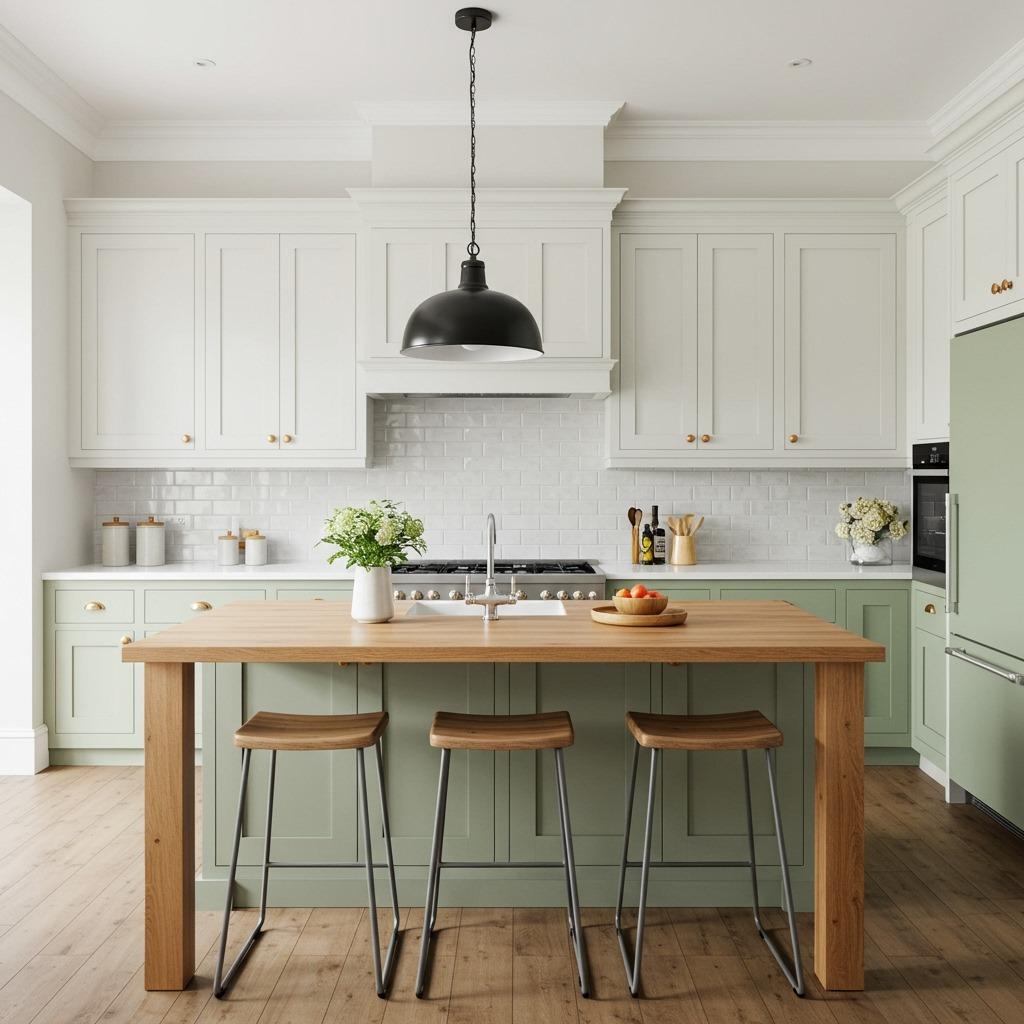
Breaking away from all-white cabinets doesn’t mean abandoning lightness and freshness. Two-tone cabinetry creates depth and visual interest while maintaining the open feel that makes modern farmhouse kitchens so appealing. The most common approach puts darker or colored cabinets below with white or cream uppers, which keeps the space feeling airy while grounding the lower portion.
Popular lower cabinet colors include sage green, navy blue, charcoal gray, or natural wood tones. These work beautifully because they’re sophisticated enough to feel current but not trendy enough to feel dated quickly. Your island offers another opportunity for color – it can match your lowers, contrast with both uppers and lowers, or introduce natural wood for that third tone we discussed earlier.
The key is maintaining enough contrast between your tones that the distinction feels intentional rather than like you ran out of paint mid-project. That said, the contrast doesn’t need to be dramatic. Even subtle variations create dimension that elevates your entire design. This approach also makes future updates easier – you can repaint one set of cabinets to refresh your look without touching everything. For more inspiration on cabinet treatments, check out two tone kitchen cabinets for detailed guidance.
Modern farmhouse kitchens succeed because they honor both past and present. The style values things made well and built to last, but doesn’t insist you live like your grandparents did. You get warmth and character without sacrificing contemporary convenience and clean lines.
What makes this approach so versatile is that it accommodates different budgets and commitment levels. Swapping hardware and adding open shelves costs relatively little but makes real visual impact. Bigger moves like replacing countertops or adding ceiling treatments require more investment but transform your entire space. Most people land somewhere in the middle, mixing smaller DIY updates with a few bigger splurges on elements they’ll use and see every single day.
The best modern farmhouse kitchens feel collected over time rather than installed all at once. So start with the ideas that resonate most strongly, the ones you keep coming back to when you’re scrolling through inspiration. Your kitchen should work for your actual life, not just look good in photos. When you get that balance right, you end up with a space that feels both magazine-worthy and genuinely yours.

